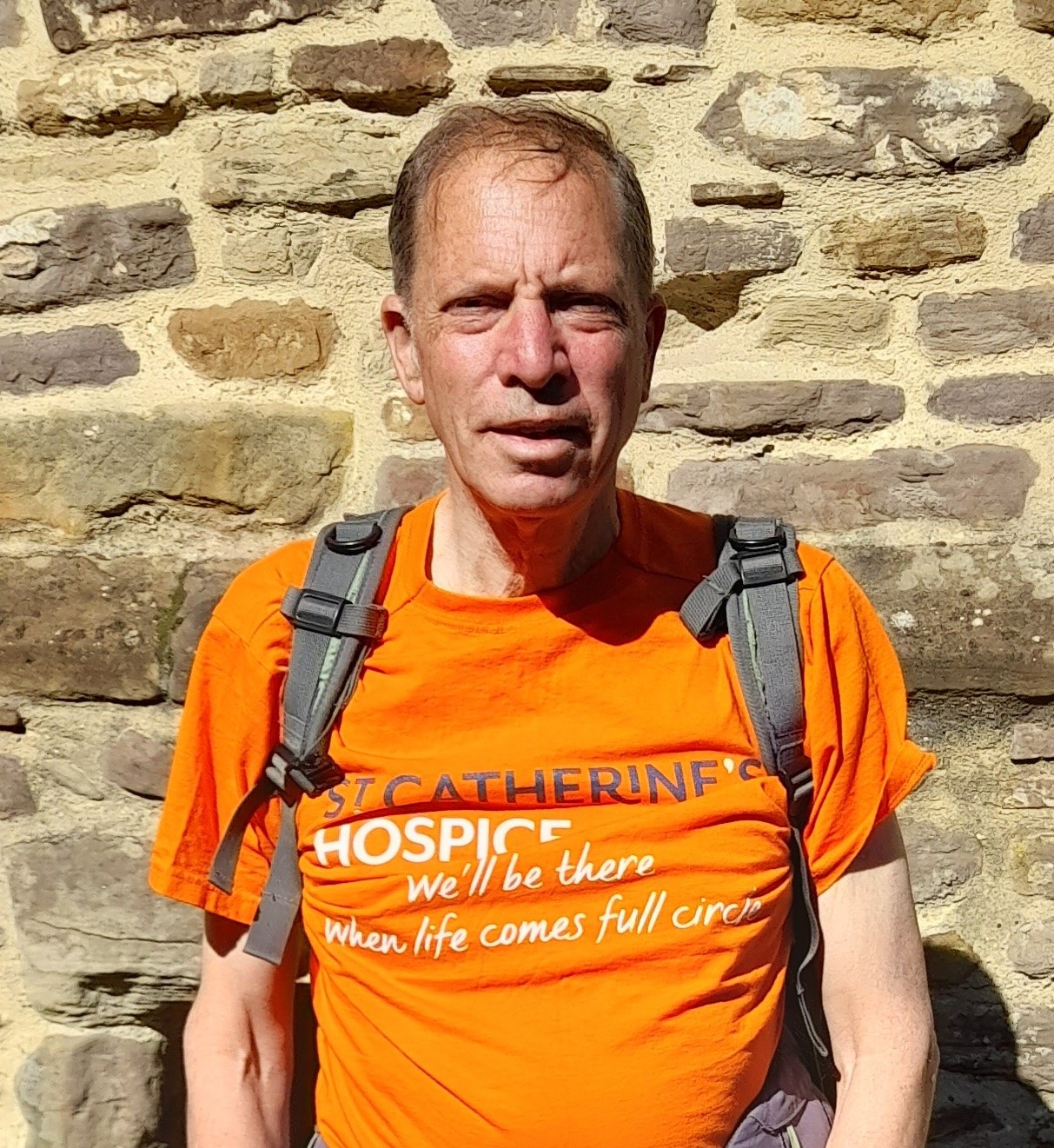
Mick Hall
Mick started his walk in Horsham just after Easter 2021 and completed it on the 26th April! Mick, who is a member of Holy Trinity Church in Horsham, raised funds for St Catherine’s Hospice in Crawley.


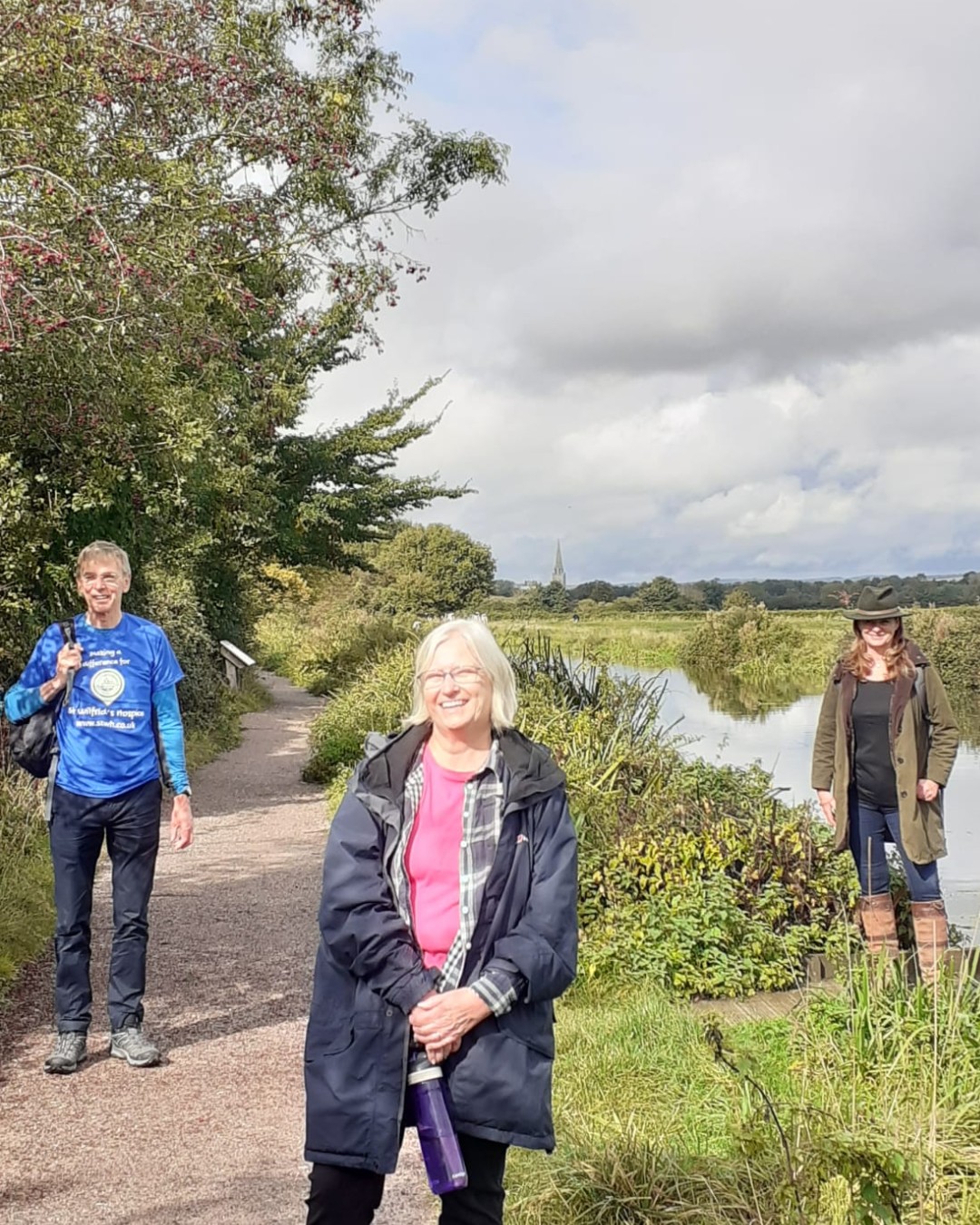
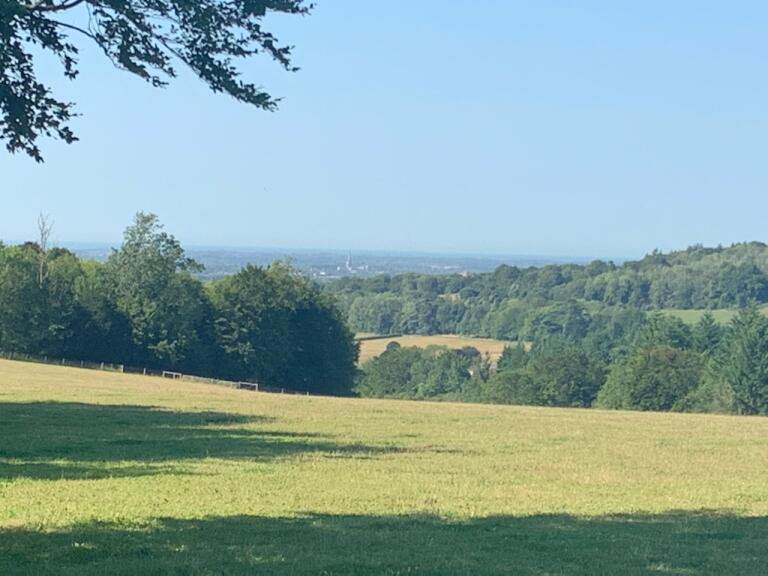 It was another wonderful morning – totally clear blue sky – not even a jet stream to be seen. The walk took me out of Halnaker alongside a long flintstone boundary wall of the Goodwood Estate Home Farm. The wall is said to have been built by French prisoners in the early 1800s. I dawdled a bit, searching the wall for fossils – a bit like beachcombing – very addictive. Not far from here is the village of Boxgrove which has played host to two memorable FSH events; our very first West Sussex event H&H4H – Hats and Handbags for Hospices – which took place in the village hall in 2014 and a magical performance of A Spanish Nativity by Stile Antico in the magnificent Priory Church of St Mary & St Blaise in 2018.
It was another wonderful morning – totally clear blue sky – not even a jet stream to be seen. The walk took me out of Halnaker alongside a long flintstone boundary wall of the Goodwood Estate Home Farm. The wall is said to have been built by French prisoners in the early 1800s. I dawdled a bit, searching the wall for fossils – a bit like beachcombing – very addictive. Not far from here is the village of Boxgrove which has played host to two memorable FSH events; our very first West Sussex event H&H4H – Hats and Handbags for Hospices – which took place in the village hall in 2014 and a magical performance of A Spanish Nativity by Stile Antico in the magnificent Priory Church of St Mary & St Blaise in 2018.
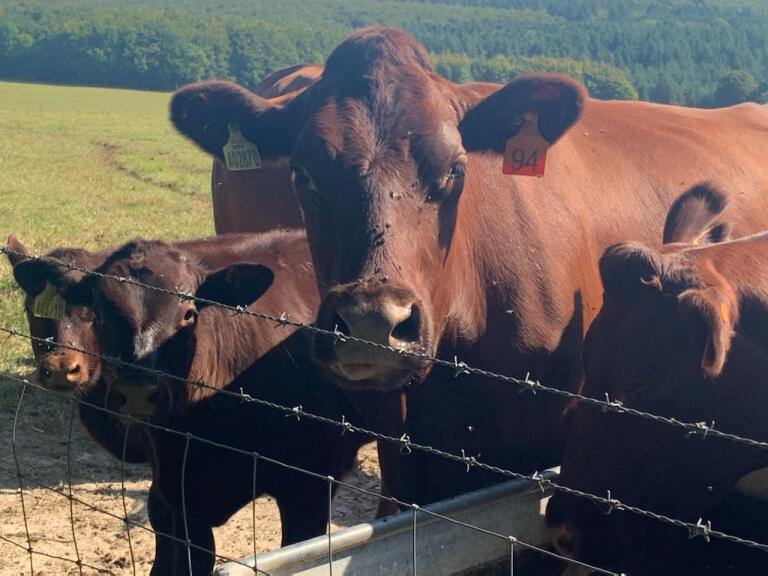 At the end of the flint stone wall I continued through a meadow and into the shade of some pretty woodland – it was so peaceful. I walked on past a field of cattle where the mothers of some very cute calves eyed me suspiciously. There were fantastic views from here looking north east across the valley. A little further on, through another copse, I found myself in the middle of another meadow with the most stunning view to the south which took in Chichester and the sea beyond. The sky above was a deep deep blue which grew paler as it neared the heat haze on the horizon ……… absolute beauty and perfection…….. heady stuff.
At the end of the flint stone wall I continued through a meadow and into the shade of some pretty woodland – it was so peaceful. I walked on past a field of cattle where the mothers of some very cute calves eyed me suspiciously. There were fantastic views from here looking north east across the valley. A little further on, through another copse, I found myself in the middle of another meadow with the most stunning view to the south which took in Chichester and the sea beyond. The sky above was a deep deep blue which grew paler as it neared the heat haze on the horizon ……… absolute beauty and perfection…….. heady stuff.
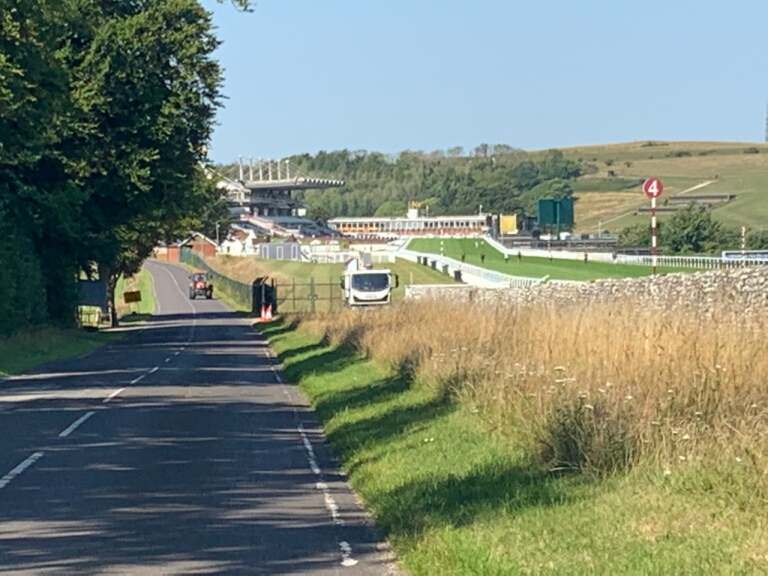 I was soon walking along a road with the grandstand of Goodwood Racecourse ahead. There would normally have been queues of traffic lining up to enter the car parks today – Glorious Goodwood is one of the highlights of the British flat horse racing calendar – but alas due to Covid-19 it would be a closed meeting today. I chatted to one of the gate marshals who told me that Sunday’s meeting was going to be open to 5,000 members as part of a government pilot. By lunch time that plan had been quashed due to ‘spikes’ in the pandemic. There was nonetheless an air of excitement as TV vans were setting up, helicopters were ferrying jockeys and trainers to the course and people in high viz vests busied themselves at the gates. Goodwood House, the home of the Duke and Duchess of Richmond and Gordon, was the venue for a fabulous musical evening in 2016 when Andrew Bernardi and his Bernardi Music Group performed Goodwood Variations in its spectacular ballroom.
Another climb took me up to St Roche’s Hill the summit of which sits at 206 metres and was once home to an Iron Age Hill fort called The Trundle. Today it is the site of two large radio masts. If I was astounded by the earlier view, I was completely bowled over by the panoramic vista from here. I could see for miles along the coast to the east, Chichester Harbour and the Isle of Wight due south and the Spinnaker Tower and Portsmouth to the west. I chatted with a family who were picnicking here and we marvelled at the spectacular view.
It was incredibly hot and exposed on the hill, so I ‘trundled’ off down a long stone track towards the distant spire of Chichester Cathedral. Halfway along this path I sat in the shade of a bush and did a live radio interview on my phone with Tony Williams at Uckfield FM.
I was soon walking along a road with the grandstand of Goodwood Racecourse ahead. There would normally have been queues of traffic lining up to enter the car parks today – Glorious Goodwood is one of the highlights of the British flat horse racing calendar – but alas due to Covid-19 it would be a closed meeting today. I chatted to one of the gate marshals who told me that Sunday’s meeting was going to be open to 5,000 members as part of a government pilot. By lunch time that plan had been quashed due to ‘spikes’ in the pandemic. There was nonetheless an air of excitement as TV vans were setting up, helicopters were ferrying jockeys and trainers to the course and people in high viz vests busied themselves at the gates. Goodwood House, the home of the Duke and Duchess of Richmond and Gordon, was the venue for a fabulous musical evening in 2016 when Andrew Bernardi and his Bernardi Music Group performed Goodwood Variations in its spectacular ballroom.
Another climb took me up to St Roche’s Hill the summit of which sits at 206 metres and was once home to an Iron Age Hill fort called The Trundle. Today it is the site of two large radio masts. If I was astounded by the earlier view, I was completely bowled over by the panoramic vista from here. I could see for miles along the coast to the east, Chichester Harbour and the Isle of Wight due south and the Spinnaker Tower and Portsmouth to the west. I chatted with a family who were picnicking here and we marvelled at the spectacular view.
It was incredibly hot and exposed on the hill, so I ‘trundled’ off down a long stone track towards the distant spire of Chichester Cathedral. Halfway along this path I sat in the shade of a bush and did a live radio interview on my phone with Tony Williams at Uckfield FM.
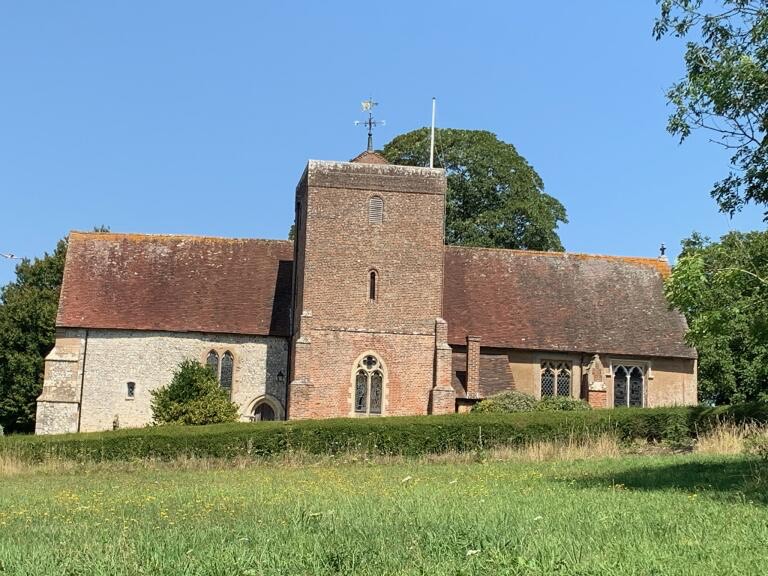 The path took me to the picturesque village of East Lavant with its flint walls and thatched cottages and then along to where I joined the Centurion Way which was once the Chichester to Midhurst Railway line.
The path took me to the picturesque village of East Lavant with its flint walls and thatched cottages and then along to where I joined the Centurion Way which was once the Chichester to Midhurst Railway line.
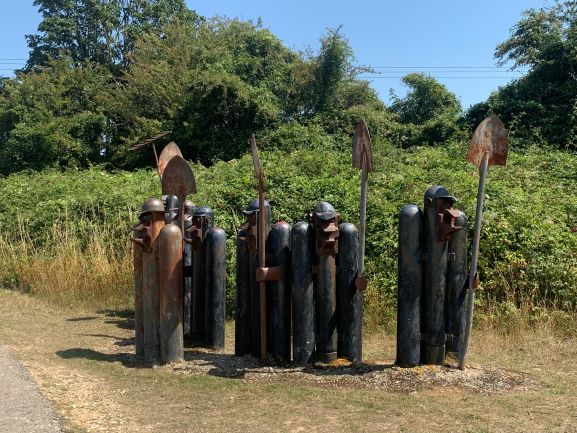 I followed this trail for two and a half miles and met The Chichester Road Gang on the way – an army of spade-wielding Roman workers made out of scrap metal – the creation of David Kemp. These wonderfully quirky sculptures mark the spot where the Roman road from Silchester to Chichester crosses the Centurion Way. I was relieved that this walk afforded a good balance of open spaces and shade which was important on a hot day such as this.
I followed this trail for two and a half miles and met The Chichester Road Gang on the way – an army of spade-wielding Roman workers made out of scrap metal – the creation of David Kemp. These wonderfully quirky sculptures mark the spot where the Roman road from Silchester to Chichester crosses the Centurion Way. I was relieved that this walk afforded a good balance of open spaces and shade which was important on a hot day such as this.
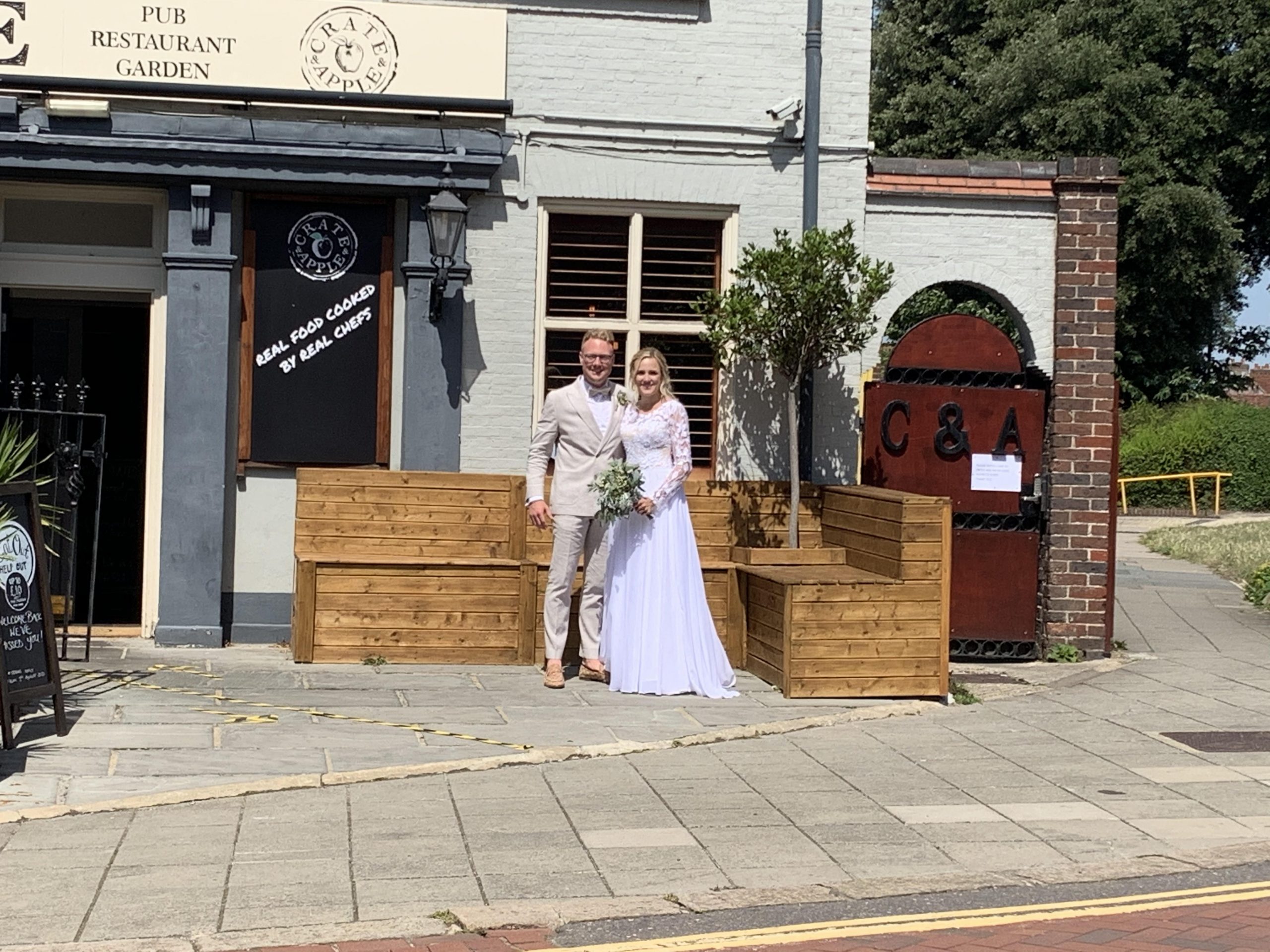 On reaching Chichester I passed The Crate & Apple pub in Westgate where a young couple were celebrating their very recent nuptials – they looked so happy and posed for me.
On reaching Chichester I passed The Crate & Apple pub in Westgate where a young couple were celebrating their very recent nuptials – they looked so happy and posed for me.
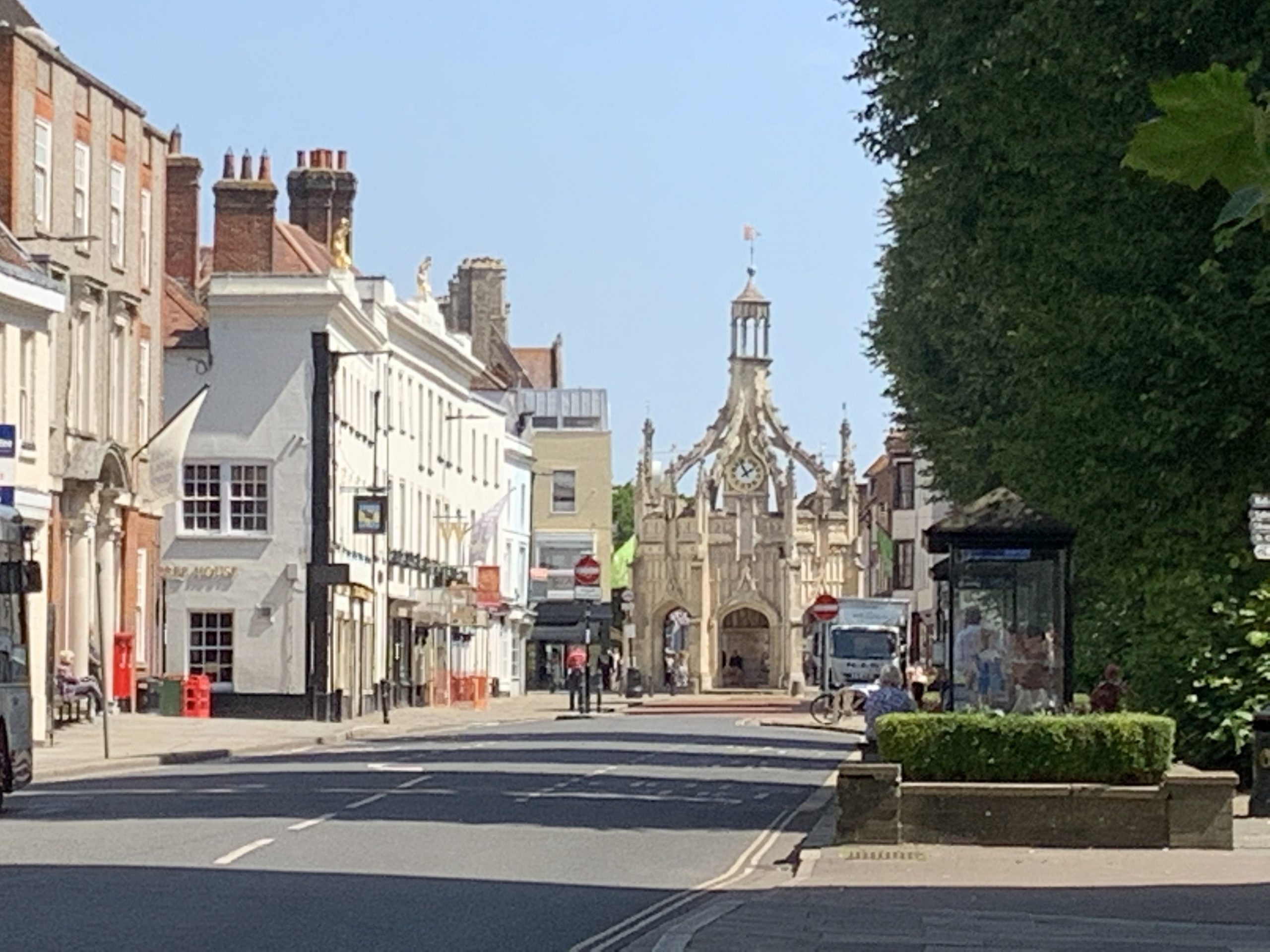 Within minutes I was in a very quiet West Street with the ornate Market Cross ahead. According to the inscription on it, the octangular cross was built by Edward Story, Bishop of Chichester from 1477-1503 so that the poor people should have somewhere to sell their wares, and as a meeting point.
Within minutes I was in a very quiet West Street with the ornate Market Cross ahead. According to the inscription on it, the octangular cross was built by Edward Story, Bishop of Chichester from 1477-1503 so that the poor people should have somewhere to sell their wares, and as a meeting point.
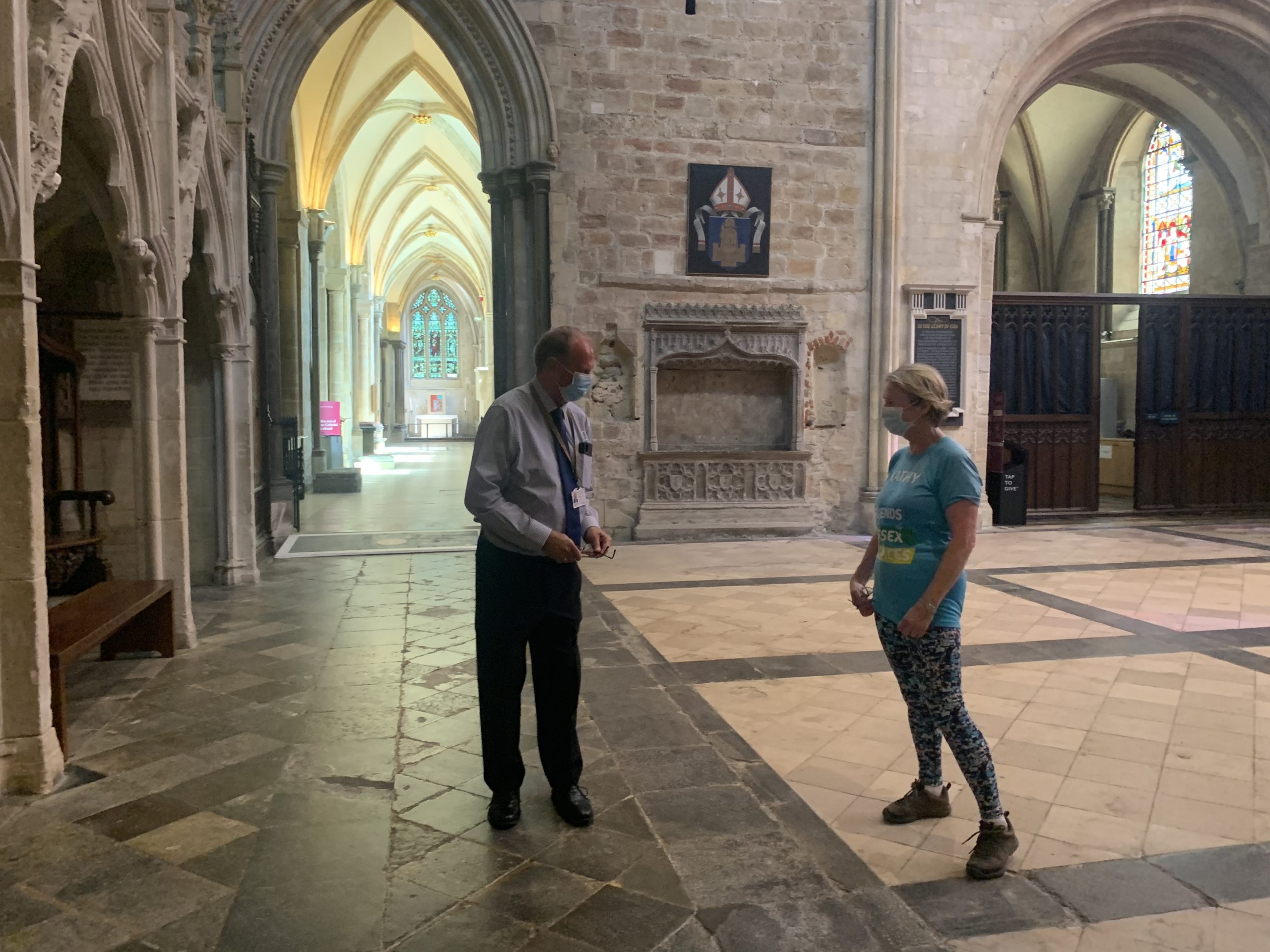 I turned and said hello to St Richard, Philip Jackson’s imposing, larger than life-size sculpture of the saint, as I headed for the cool asylum of the cathedral. Inside I chatted with some of the guides who were helping visitors negotiate the social distancing/sanitising routine and sought out Howard Waddell, the Head Verger, who has remained a friend of FSH since the Hymnathon we held at the cathedral in 2013.
I turned and said hello to St Richard, Philip Jackson’s imposing, larger than life-size sculpture of the saint, as I headed for the cool asylum of the cathedral. Inside I chatted with some of the guides who were helping visitors negotiate the social distancing/sanitising routine and sought out Howard Waddell, the Head Verger, who has remained a friend of FSH since the Hymnathon we held at the cathedral in 2013.
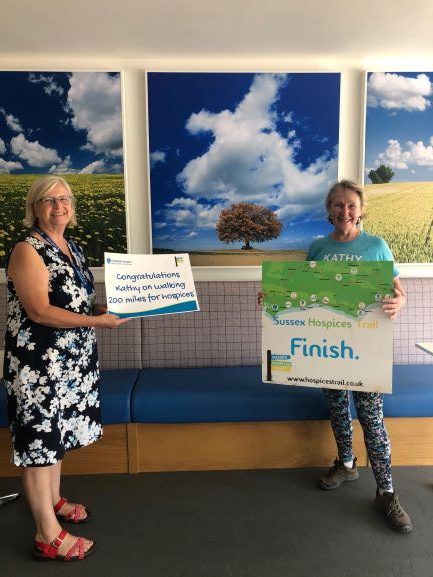 I finished this amazing journey at St Wilfrid’s Hospice, now in its beautiful new building at Bosham where I was greeted by Soline Jerram, Chairman, Alex Burch, Community Fundraising Manager, and several of their colleagues. They presented me with a bottle of bubbly which I saved for later that evening and we sat and talked over a refreshing cup of tea.
St Wilfrid’s Hospice has been supporting people in its community living with terminal illness, for over 30 years. Its catchment area runs between Emsworth to the west, Arundel to the east and south of the downs to the coast – a community of over 80,000 households. The new hospice building opened in July last year. The intention was to utilise 14 of its 18 beds initially, however the additional four beds have been used throughout the Covid-19 pandemic and are being supported by NHS funding. The majority of St Wilfrid’s care takes place in people’s homes. Running costs are just over £8 million, of which approximately 15% is received from the NHS.
On the long stretches of my walk I was able to reflect on today’s words in my book of Buddhist offerings which read: “The art of happiness begins with developing an understanding of what are the truest sources of happiness, and setting our priorities in life based on the cultivation of those sources.” I believe this journey has helped me to go deep within and discern the things that bring me true happiness as well as the things that don’t. I think I know the sources I have to cultivate and those things which I need to let go of. The words from T S Elliott’s Four Quartets, quoted at the top of today’s diary resonate with me because throughout this circular perambulation of the Sussex Hospices Trail, exploration was what I was doing, not only of this beautiful county of Sussex but a deeper exploration within.
[This section of the trail was sponsored by Michael and Maureen Chowen, stalwart supporters of FSH. They have generously supported numerous FSH events and made possible successful collaboration initiatives. Michael is a Patron of FSH and Chestnut Tree House and Maureen is a Trustee of St Barnabas and Chestnut Tree House.]
I finished this amazing journey at St Wilfrid’s Hospice, now in its beautiful new building at Bosham where I was greeted by Soline Jerram, Chairman, Alex Burch, Community Fundraising Manager, and several of their colleagues. They presented me with a bottle of bubbly which I saved for later that evening and we sat and talked over a refreshing cup of tea.
St Wilfrid’s Hospice has been supporting people in its community living with terminal illness, for over 30 years. Its catchment area runs between Emsworth to the west, Arundel to the east and south of the downs to the coast – a community of over 80,000 households. The new hospice building opened in July last year. The intention was to utilise 14 of its 18 beds initially, however the additional four beds have been used throughout the Covid-19 pandemic and are being supported by NHS funding. The majority of St Wilfrid’s care takes place in people’s homes. Running costs are just over £8 million, of which approximately 15% is received from the NHS.
On the long stretches of my walk I was able to reflect on today’s words in my book of Buddhist offerings which read: “The art of happiness begins with developing an understanding of what are the truest sources of happiness, and setting our priorities in life based on the cultivation of those sources.” I believe this journey has helped me to go deep within and discern the things that bring me true happiness as well as the things that don’t. I think I know the sources I have to cultivate and those things which I need to let go of. The words from T S Elliott’s Four Quartets, quoted at the top of today’s diary resonate with me because throughout this circular perambulation of the Sussex Hospices Trail, exploration was what I was doing, not only of this beautiful county of Sussex but a deeper exploration within.
[This section of the trail was sponsored by Michael and Maureen Chowen, stalwart supporters of FSH. They have generously supported numerous FSH events and made possible successful collaboration initiatives. Michael is a Patron of FSH and Chestnut Tree House and Maureen is a Trustee of St Barnabas and Chestnut Tree House.]  I looked up and the sky had an “x” where two jet streams had crossed – batty I know but when I see these I imagine they’re kisses blown to me from lost loved ones – anyway, it gave me an extra boost so that my boots were now turbo charged for the ten mile walk ahead.
I looked up and the sky had an “x” where two jet streams had crossed – batty I know but when I see these I imagine they’re kisses blown to me from lost loved ones – anyway, it gave me an extra boost so that my boots were now turbo charged for the ten mile walk ahead.
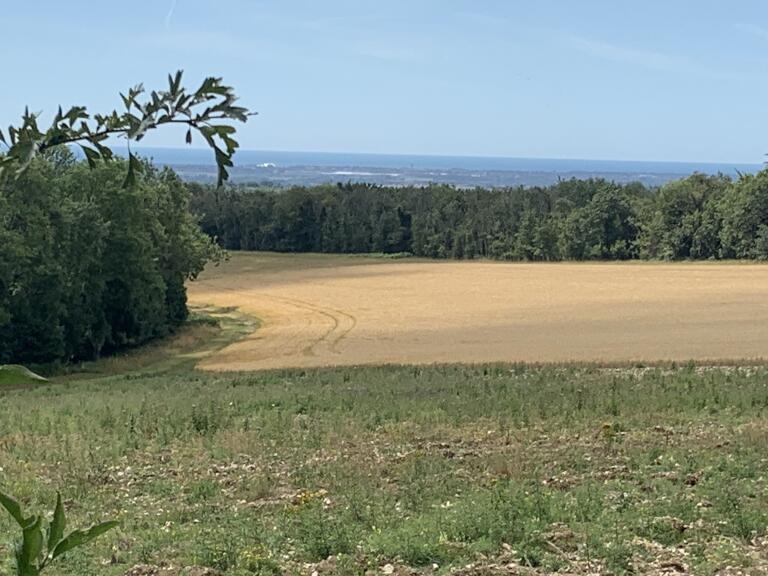 I was soon in the village of Houghton and continued past The George & Dragon, which was festooned with a colourful array of hanging baskets.
I was soon in the village of Houghton and continued past The George & Dragon, which was festooned with a colourful array of hanging baskets.
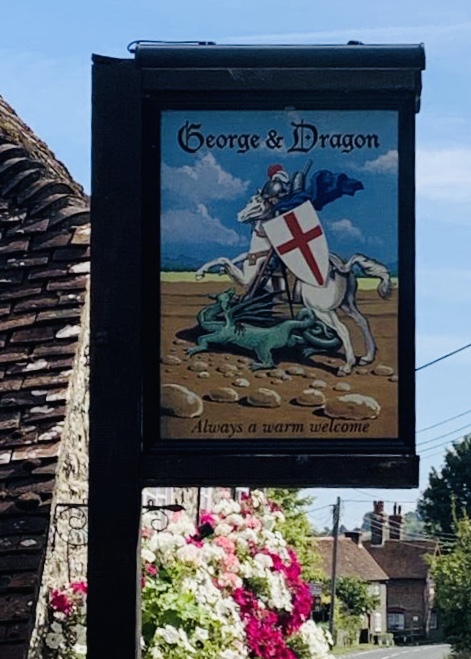 After an uphill walk through some pretty woods, I emerged into a golden field of barley with the most fabulous long distance views of rolling hills and fields dotted with copses. To the south I could see the English Channel populated with an armada of wind turbines, and to the north the distant ridge of the High Weald.
After an uphill walk through some pretty woods, I emerged into a golden field of barley with the most fabulous long distance views of rolling hills and fields dotted with copses. To the south I could see the English Channel populated with an armada of wind turbines, and to the north the distant ridge of the High Weald.
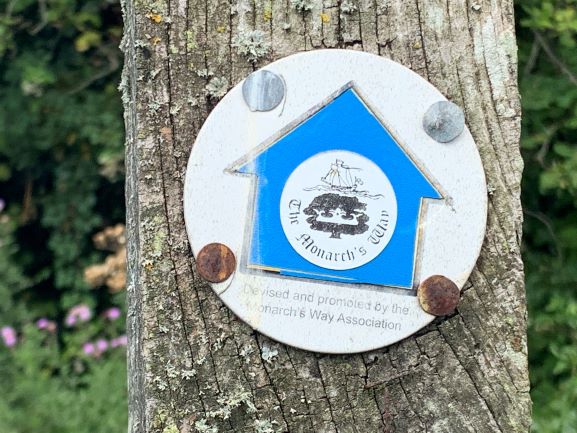 The walk goes along part of the Monarch’s Way, a 615-mile long-distance walking trail that runs from Worcester to Shoreham-by-Sea. It follows the escape route taken by Charles II after defeat by Cromwell in the final battle of the Civil Wars at Worcester in 1651, when for six weeks the 21-year-old was hotly pursued by Parliamentary troops.
The walk goes along part of the Monarch’s Way, a 615-mile long-distance walking trail that runs from Worcester to Shoreham-by-Sea. It follows the escape route taken by Charles II after defeat by Cromwell in the final battle of the Civil Wars at Worcester in 1651, when for six weeks the 21-year-old was hotly pursued by Parliamentary troops.
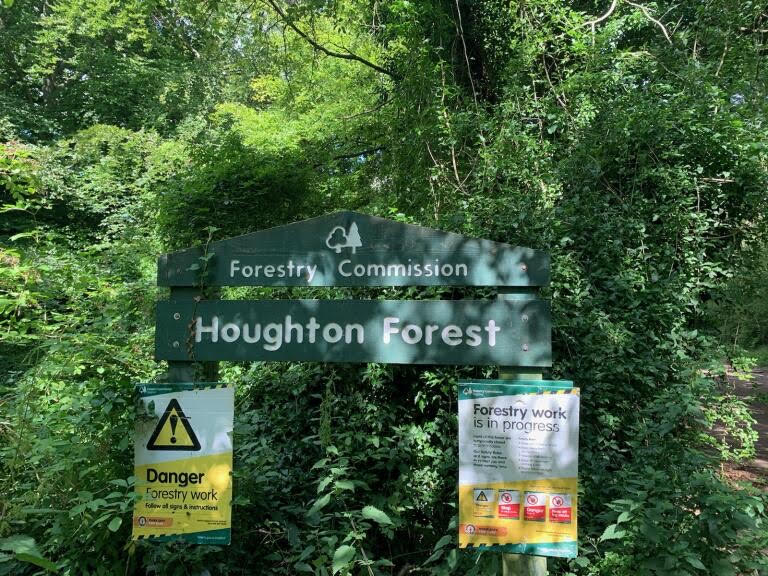 The next mile or so took me through Houghton Forest and I stopped and chatted with a couple of walkers and a lost cyclist. On reaching Bignor Hill, I sat for a while on a bench carved from a tree trunk, and gazed at the breathtaking view. I continued along the ridge of the old Roman road – Stane Street – a 56-mile road built circa 70AD that connected London to Chichester. As I walked I pondered how many legions of Roman soldiers and others had trodden this path in the ensuing 1950 years. Some quite tame sheep allowed me to get quite close and I think actually posed obligingly. I took loads of photos but I don’t feel they did justice to the beauty of my surroundings.
The next mile or so took me through Houghton Forest and I stopped and chatted with a couple of walkers and a lost cyclist. On reaching Bignor Hill, I sat for a while on a bench carved from a tree trunk, and gazed at the breathtaking view. I continued along the ridge of the old Roman road – Stane Street – a 56-mile road built circa 70AD that connected London to Chichester. As I walked I pondered how many legions of Roman soldiers and others had trodden this path in the ensuing 1950 years. Some quite tame sheep allowed me to get quite close and I think actually posed obligingly. I took loads of photos but I don’t feel they did justice to the beauty of my surroundings.
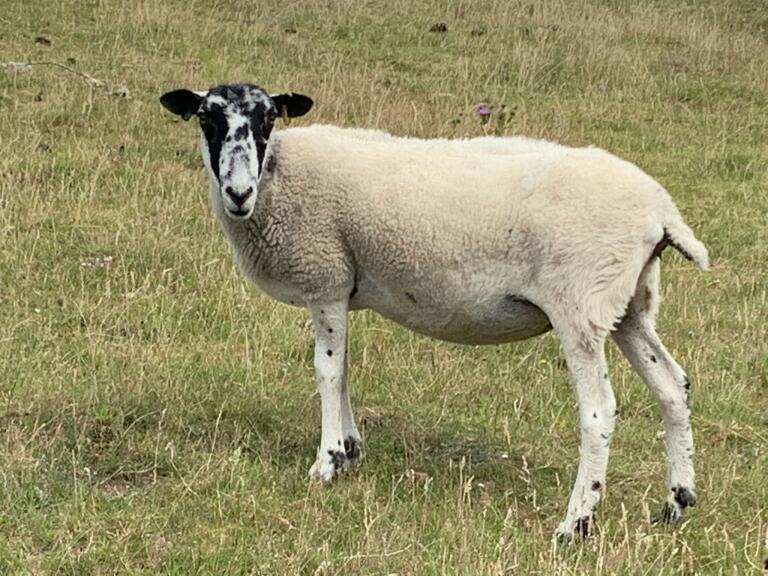 The great thing about this walk – as I’ve found with all of the walks so far – is there was a good balance of wide open spaces and woodland shade.There were long stretches on this walk where I could meditate and even do some chanting – which might have frightened a few animals.In the next woodland, I came upon some thick woody vines hanging from the tree canopy – I tugged on a couple and was only prevented from doing a Tarzan by the sound of approaching walkers…….. probably just as well.
The great thing about this walk – as I’ve found with all of the walks so far – is there was a good balance of wide open spaces and woodland shade.There were long stretches on this walk where I could meditate and even do some chanting – which might have frightened a few animals.In the next woodland, I came upon some thick woody vines hanging from the tree canopy – I tugged on a couple and was only prevented from doing a Tarzan by the sound of approaching walkers…….. probably just as well.
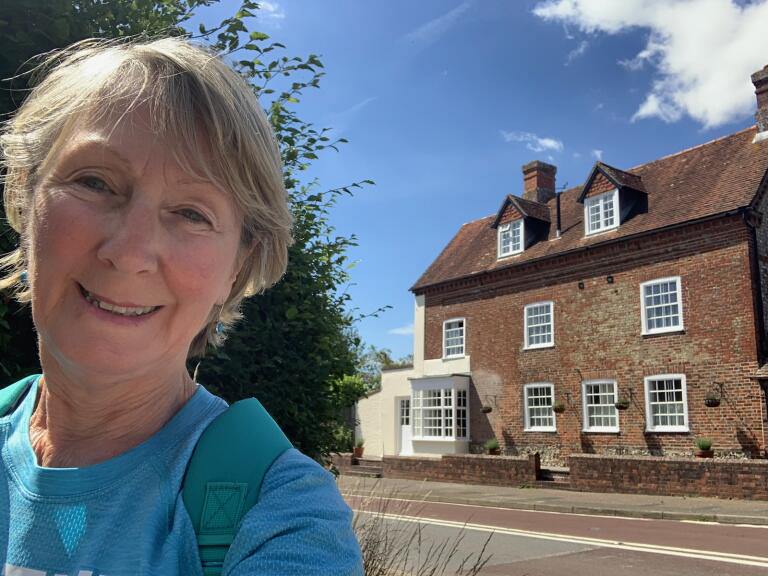 The trail took me along the edge of a vineyard, where I stopped and rested at a stile, then on past Halnaker Windmill which looked so pretty perched on the hill, and on to Halnaker.
The trail took me along the edge of a vineyard, where I stopped and rested at a stile, then on past Halnaker Windmill which looked so pretty perched on the hill, and on to Halnaker.
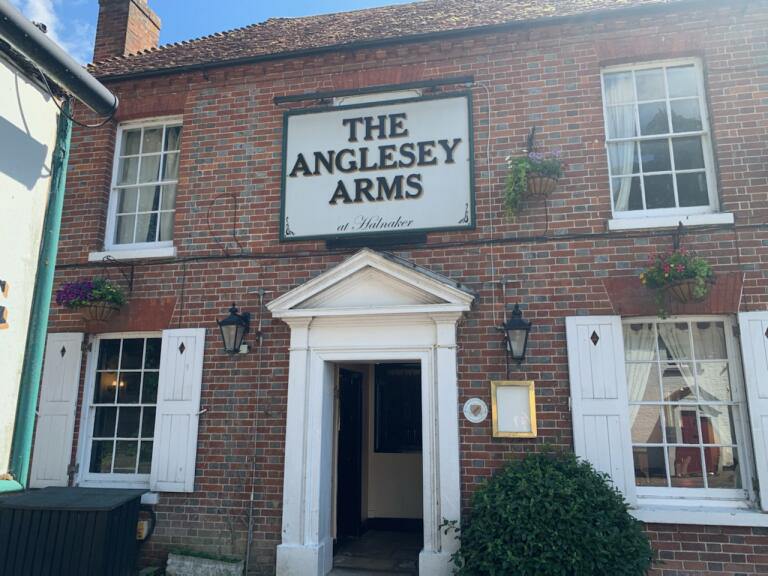 I’d left my car in the car park of The Anglesey Arms and popped in to say thank you to Alan Collier, father of landlord, Christopher, and Lucy who were behind the bar. One more walk to go……
I’d left my car in the car park of The Anglesey Arms and popped in to say thank you to Alan Collier, father of landlord, Christopher, and Lucy who were behind the bar. One more walk to go……
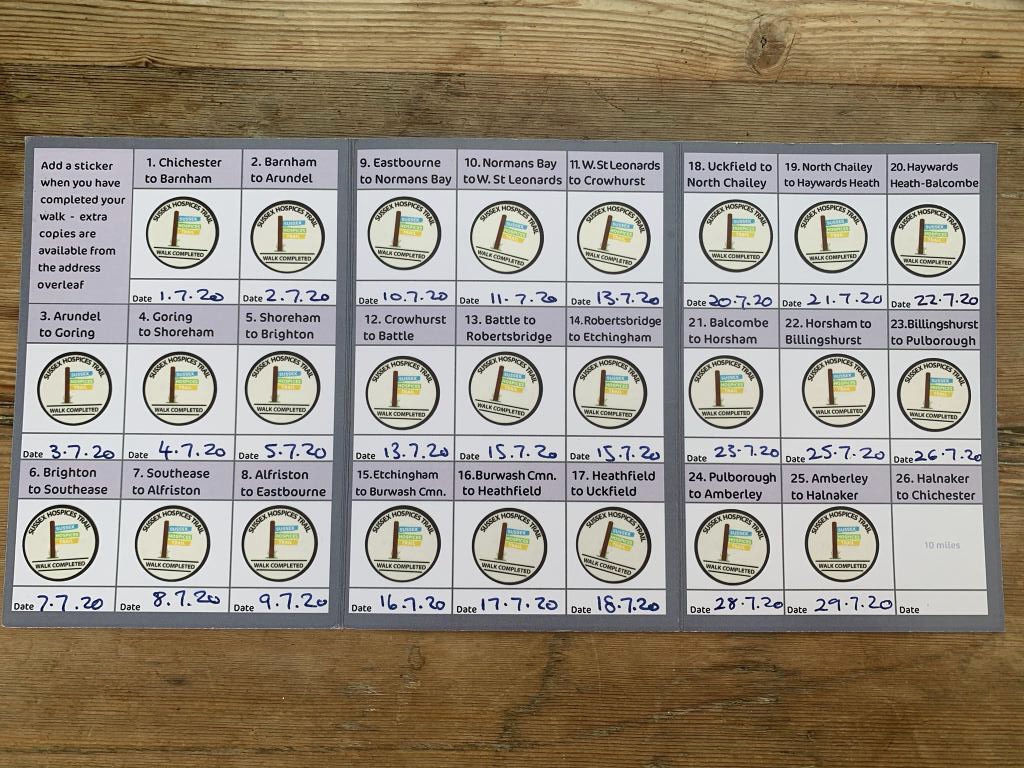 This section of the trail was sponsored by Chris & Karen Thorne and dedicated to all Sussex hospice care providers. Chris’s mum, Reynie Thorne, spent her final days in St Wilfrid’s, Eastbourne in 2010 ‘where she was looked after with such amazing care and compassion’.
This section of the trail was sponsored by Chris & Karen Thorne and dedicated to all Sussex hospice care providers. Chris’s mum, Reynie Thorne, spent her final days in St Wilfrid’s, Eastbourne in 2010 ‘where she was looked after with such amazing care and compassion’.
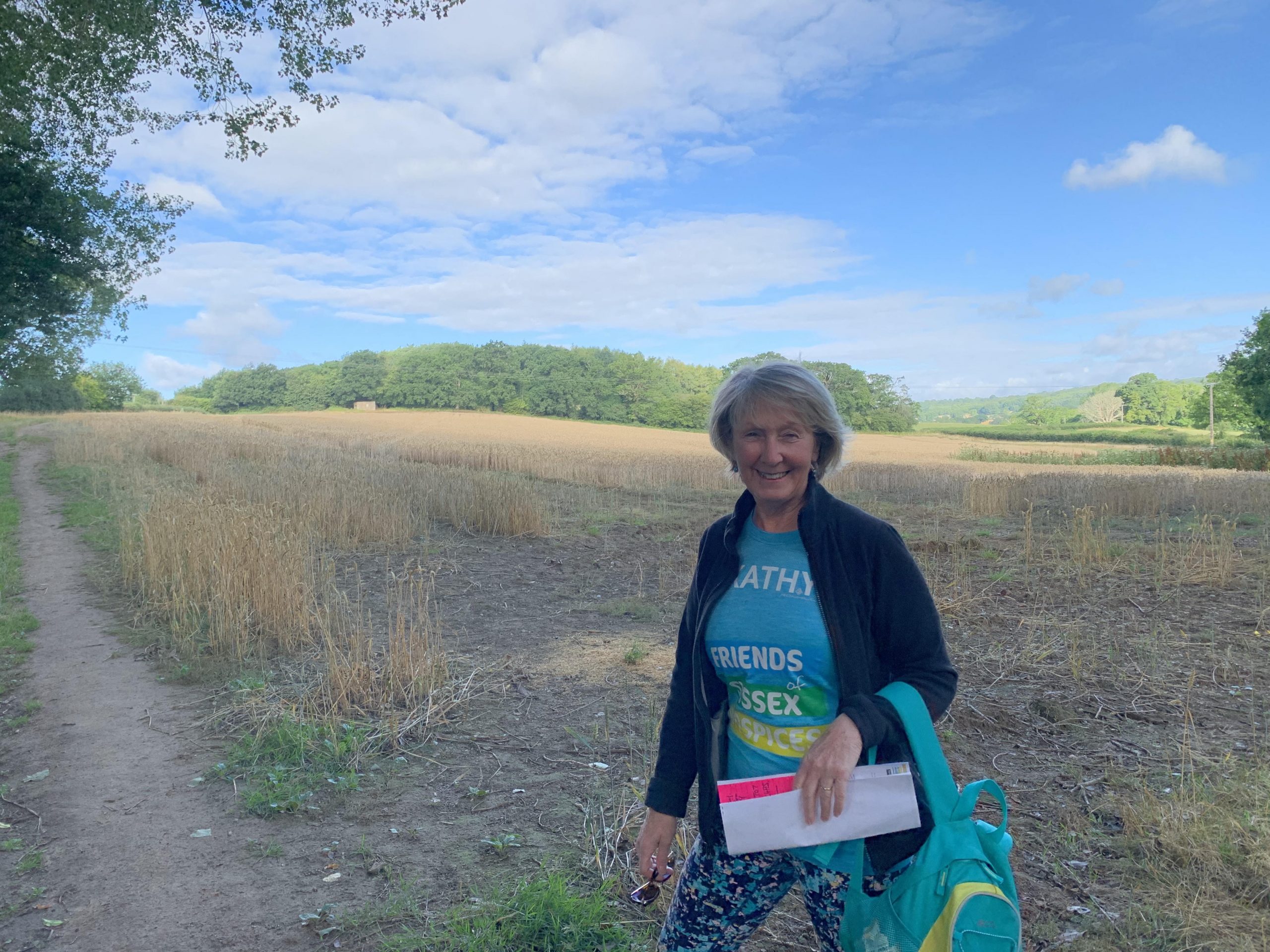 It was a lovely bright sunny morning as I set off and having climbed a few paces from the lane onto a wheatfield, I met with the most fabulous panoramic view taking in the South Downs and the High Weald as far as the eye could see. This scenery surrounded me for pretty much all of this walk. On the other side of the wheatfield, slightly elevated, was a concrete pill box built in 1940 as part of the line of defence running from the coast, following the course of the River Arun.
It was a lovely bright sunny morning as I set off and having climbed a few paces from the lane onto a wheatfield, I met with the most fabulous panoramic view taking in the South Downs and the High Weald as far as the eye could see. This scenery surrounded me for pretty much all of this walk. On the other side of the wheatfield, slightly elevated, was a concrete pill box built in 1940 as part of the line of defence running from the coast, following the course of the River Arun.
 The walk continued through a pretty woodland and emerged again into a big sky with magnificent views. On crossing the A283 I found myself on the bank of the River Arun, on the other bank cattle and a large flock of Canada Geese were grazing. It was just dreamy walking along this path. I crossed a bridge over The Arun and after a short distance, crossed another bridge but this time over The River Rother (the east end girl in me calls it the River Rovver) the two rivers meet a few hundred yards to the east between the two bridges.
The walk continued through a pretty woodland and emerged again into a big sky with magnificent views. On crossing the A283 I found myself on the bank of the River Arun, on the other bank cattle and a large flock of Canada Geese were grazing. It was just dreamy walking along this path. I crossed a bridge over The Arun and after a short distance, crossed another bridge but this time over The River Rother (the east end girl in me calls it the River Rovver) the two rivers meet a few hundred yards to the east between the two bridges.
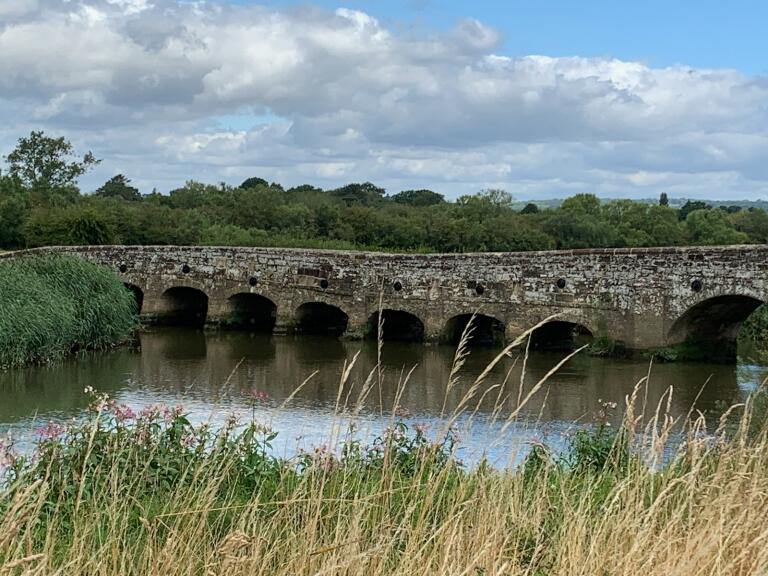 On reaching Greatham Bridge, which is a scheduled Historic Monument, I sat and munched a protein bar whilst admiring it and thinking about the comings and goings it must have witnessed since it was built in the late 13th century. It is a very special feature of this lovely part of the Arun Valley.
On reaching Greatham Bridge, which is a scheduled Historic Monument, I sat and munched a protein bar whilst admiring it and thinking about the comings and goings it must have witnessed since it was built in the late 13th century. It is a very special feature of this lovely part of the Arun Valley.
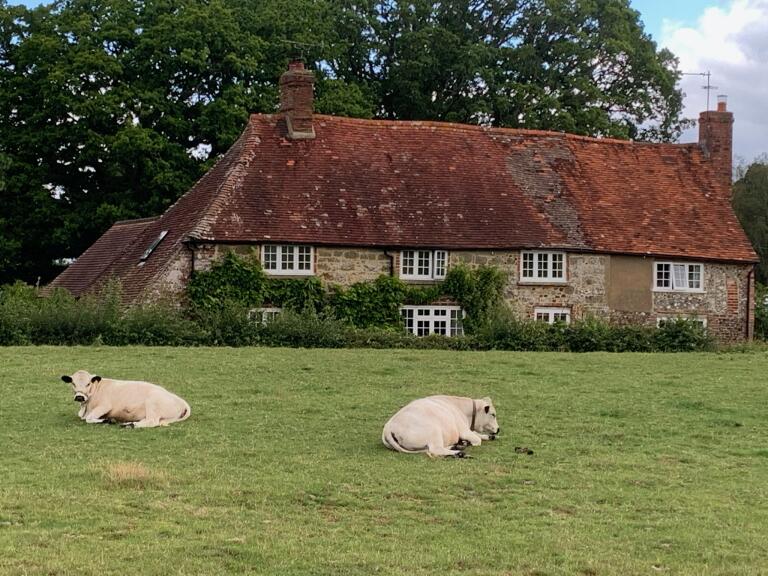 There were some beautiful houses and farm buildings throughout the walk and lots of camera friendly cattle and sheep. The walk took me across the Amberley Wildbrooks Nature Reserve, an extensive flat area of grassland, criss-crossed by ditches, supporting a fantastic array of wetland plants and insects as well as wildfowl such as teal, lapwings and snipe.
There were some beautiful houses and farm buildings throughout the walk and lots of camera friendly cattle and sheep. The walk took me across the Amberley Wildbrooks Nature Reserve, an extensive flat area of grassland, criss-crossed by ditches, supporting a fantastic array of wetland plants and insects as well as wildfowl such as teal, lapwings and snipe.
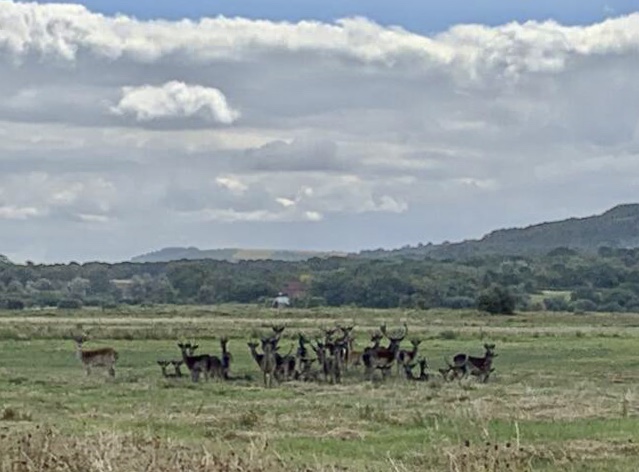 As I looked up from my guide notes I was surprised to see to my left a herd of about twenty deer only 50 yards away, just looking at me. We observed each other for quite some time before they all turned and sprang away. I watched as they lined up to cross a ditch, one by one, splashing as they crossed. Every now and then I heard a train chattering in the distance. Oddly, the sound wasn’t unpleasant, it didn’t jarr and it felt as though it had a place in these peaceful surroundings. Apart from the wildlife, I didn’t see another soul across the whole of this reserve and felt so privileged to have it all to myself.
As I looked up from my guide notes I was surprised to see to my left a herd of about twenty deer only 50 yards away, just looking at me. We observed each other for quite some time before they all turned and sprang away. I watched as they lined up to cross a ditch, one by one, splashing as they crossed. Every now and then I heard a train chattering in the distance. Oddly, the sound wasn’t unpleasant, it didn’t jarr and it felt as though it had a place in these peaceful surroundings. Apart from the wildlife, I didn’t see another soul across the whole of this reserve and felt so privileged to have it all to myself.
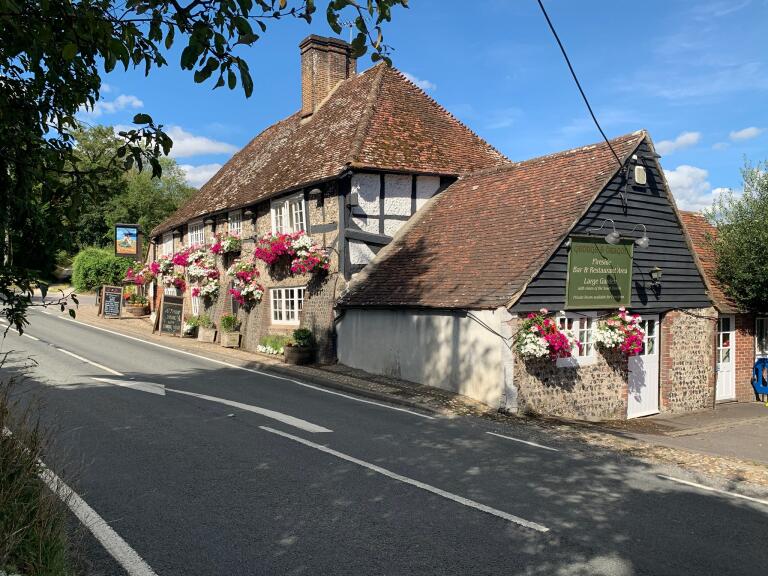 On reaching Amberley Village I was bowled over by how beautiful it was – I’d never been to Amberley Village before.
On reaching Amberley Village I was bowled over by how beautiful it was – I’d never been to Amberley Village before.
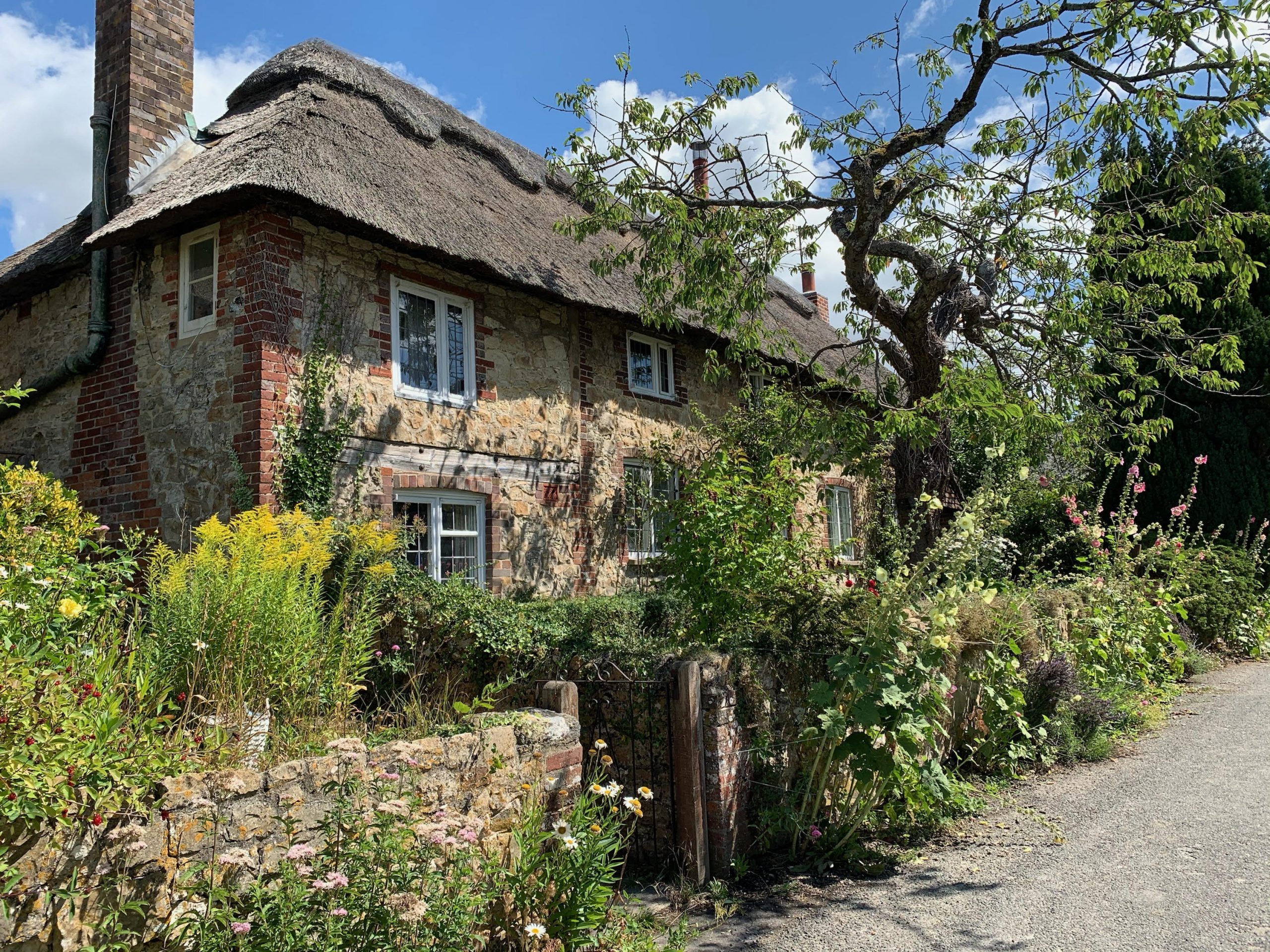 The pretty thatched cottages along its lanes were just dreamy – I think I photographed every house in the village.
The pretty thatched cottages along its lanes were just dreamy – I think I photographed every house in the village.
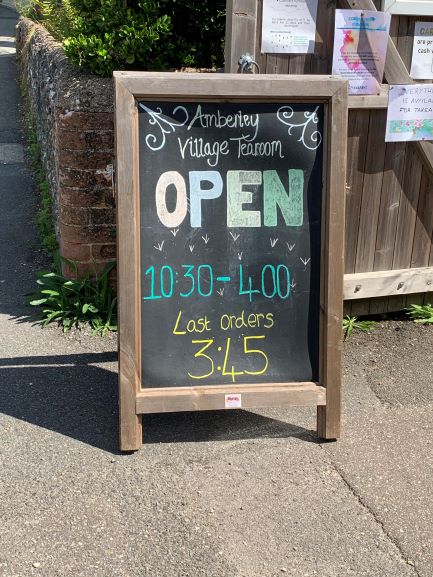 The Amberley Village Tea Room was open for business with people eating on tables outside in the sunshine.
The Amberley Village Tea Room was open for business with people eating on tables outside in the sunshine.
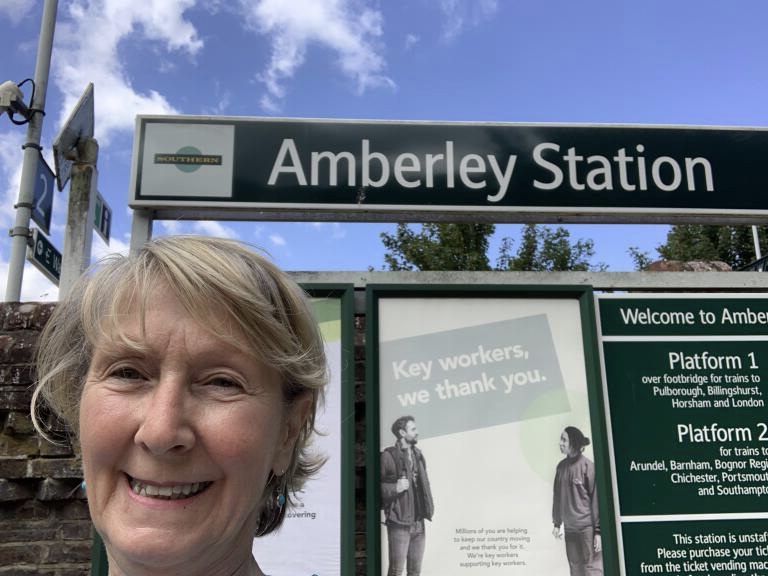 Once through the village I had a steep walk up the scarp slope of the South Downs before reaching Amberley Station where I was met by Margaret Bamford who ferried me back to Caroline & David Nicholl’s house where we had a delightful lunch.
This was a superb walk – the paths throughout were relatively clear and dry though I’d imagine after a lot of rain they might be very muddy, particularly across the reserve.
This section of the Trail was generously sponsored in 2016 by Lord and Lady Fellowes who have enjoyed walking these paths when staying nearby. Julian and Emma are staunch supporters of FSH, Julian performed at one of our early Pashley Manor Concerts and more recently, alongside Hugh Bonneville, at a dinner at Arundel Castle.
Once through the village I had a steep walk up the scarp slope of the South Downs before reaching Amberley Station where I was met by Margaret Bamford who ferried me back to Caroline & David Nicholl’s house where we had a delightful lunch.
This was a superb walk – the paths throughout were relatively clear and dry though I’d imagine after a lot of rain they might be very muddy, particularly across the reserve.
This section of the Trail was generously sponsored in 2016 by Lord and Lady Fellowes who have enjoyed walking these paths when staying nearby. Julian and Emma are staunch supporters of FSH, Julian performed at one of our early Pashley Manor Concerts and more recently, alongside Hugh Bonneville, at a dinner at Arundel Castle.
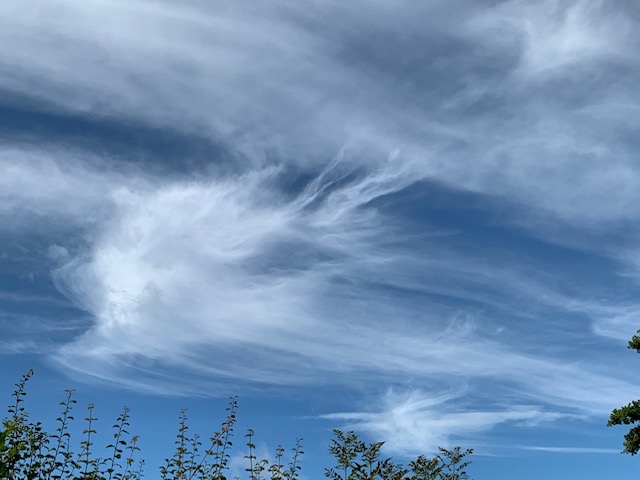 Walking across a huge playing field with football nets and rugby posts – not a soul around – there, sitting in the middle of the field, all on its own, was a white football. …
Walking across a huge playing field with football nets and rugby posts – not a soul around – there, sitting in the middle of the field, all on its own, was a white football. …
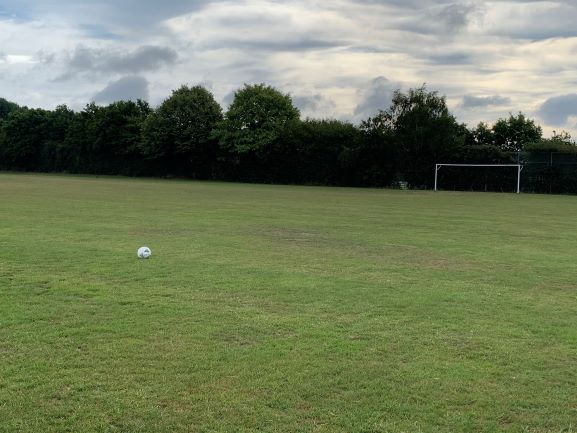 I just couldn’t resist it……I looked all around….. not a soul….. I ran towards it and gave it all the welly I could muster! It shot off at an angle and travelled all of about ten yards…. It was a good feeling though.
I just couldn’t resist it……I looked all around….. not a soul….. I ran towards it and gave it all the welly I could muster! It shot off at an angle and travelled all of about ten yards…. It was a good feeling though.
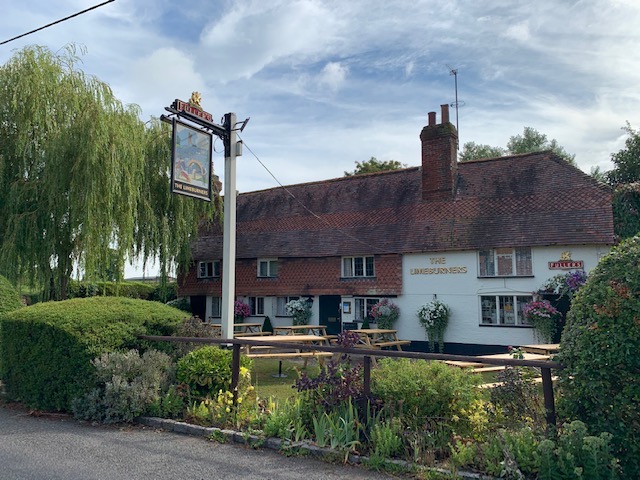 I passed The Limeburners pub, originally a row of three lime-workers’ cottages built in the 17th century. Limestone or chalk from the South Downs was burned to make lime for use in building as a mortar and as a soil fertilizer/improver to reduce acidity and make heavy clay soils more friable. The term ‘limelight’ comes from a type of stage lighting once used in theatres and music halls where cylinders of quicklime were burned to produce an intense light. I am learning all sorts of things on this walk.
I passed The Limeburners pub, originally a row of three lime-workers’ cottages built in the 17th century. Limestone or chalk from the South Downs was burned to make lime for use in building as a mortar and as a soil fertilizer/improver to reduce acidity and make heavy clay soils more friable. The term ‘limelight’ comes from a type of stage lighting once used in theatres and music halls where cylinders of quicklime were burned to produce an intense light. I am learning all sorts of things on this walk.
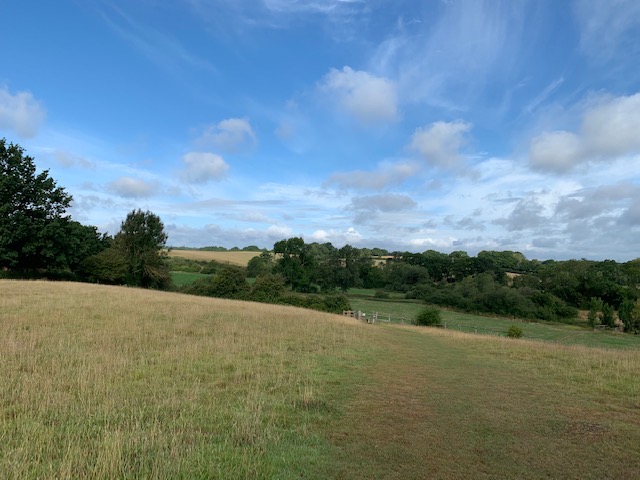 A little further along, the pastoral views from above Guildenhurst Manor took my breath away – two young deer in the meadow below looked up, twitched their ears and carried on nibbling the grass. Word had obviously reached them that I posed no threat as I couldn’t even kick a football more than ten yards!
A little further along, the pastoral views from above Guildenhurst Manor took my breath away – two young deer in the meadow below looked up, twitched their ears and carried on nibbling the grass. Word had obviously reached them that I posed no threat as I couldn’t even kick a football more than ten yards!
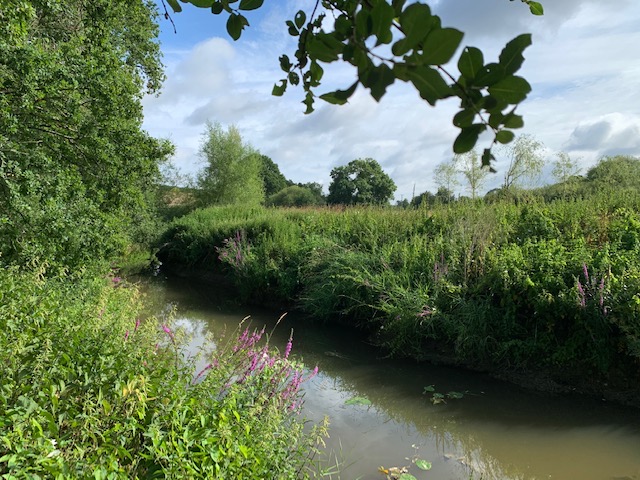 The path descended and meandered alongside the River Arun. The air was fresh after the previous day’s rain and lots of different butterflies fluttered along before me – it felt as though I was in a Disney film. I saw lots of blackthorn bushes laden with plump sloes – they looked ripe enough for picking but it’s surely far too early?
The path descended and meandered alongside the River Arun. The air was fresh after the previous day’s rain and lots of different butterflies fluttered along before me – it felt as though I was in a Disney film. I saw lots of blackthorn bushes laden with plump sloes – they looked ripe enough for picking but it’s surely far too early?
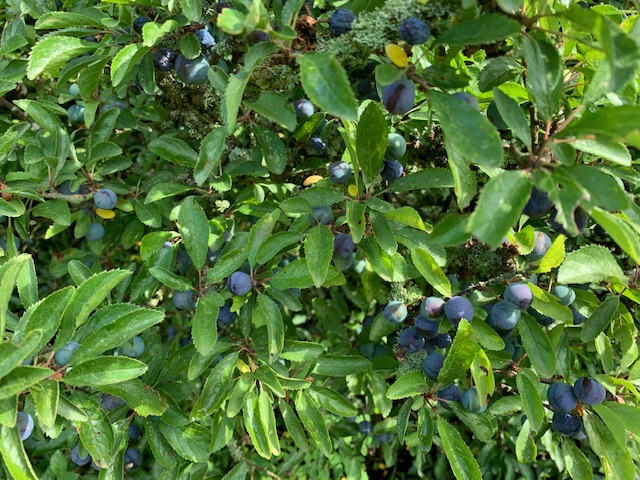 A little way along I reached Lordings Lock, once part of an important canal trade route, the Wey and Arun Canal.
A little way along I reached Lordings Lock, once part of an important canal trade route, the Wey and Arun Canal.
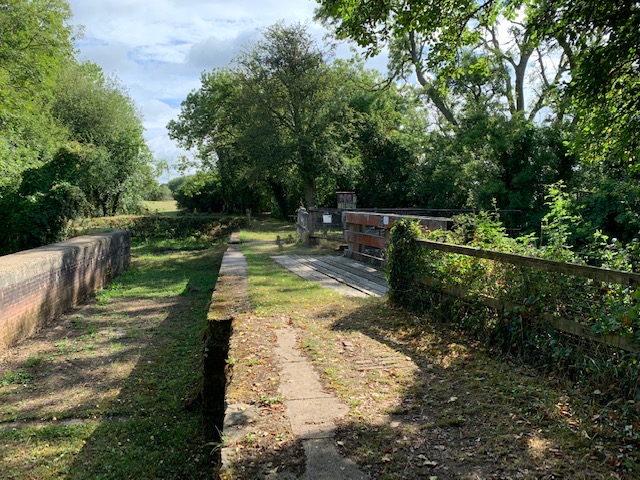 My guide notes told me that in the 1800s it was possible to travel by boat from The Thames in London to Littlehampton on the south coast.
My guide notes told me that in the 1800s it was possible to travel by boat from The Thames in London to Littlehampton on the south coast.
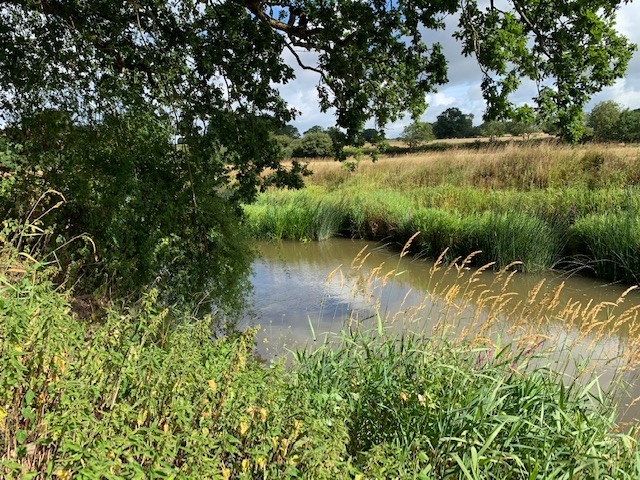 The route was via the rivers Wey and Arun, linked by the 23-mile Wey and Arun Canal. By 1871, railway competition was fierce and the canal was abandoned.
The route was via the rivers Wey and Arun, linked by the 23-mile Wey and Arun Canal. By 1871, railway competition was fierce and the canal was abandoned.
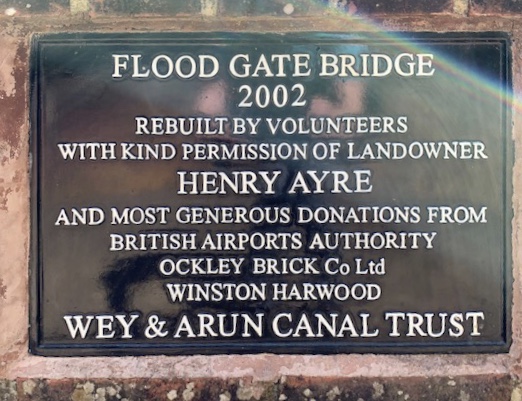 Since 1970, the Wey and Arun Canal Trust has been restoring many of the locks and bridges, with the intention of one day reopening the whole canal.
Since 1970, the Wey and Arun Canal Trust has been restoring many of the locks and bridges, with the intention of one day reopening the whole canal.
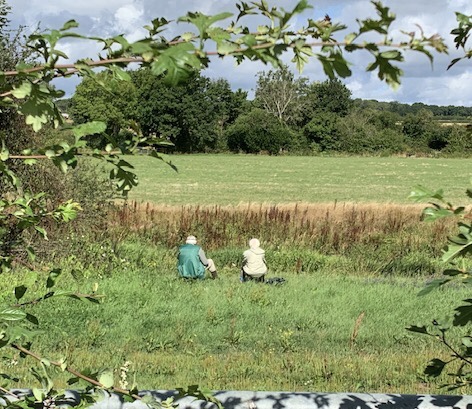 Further along, through a gate in the hedge, I saw a couple sitting on the bank of the river – it was such a lovely, peaceful scene.
Further along, through a gate in the hedge, I saw a couple sitting on the bank of the river – it was such a lovely, peaceful scene.
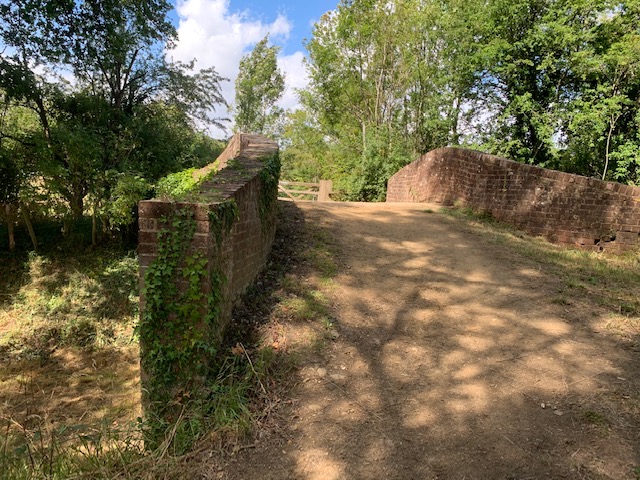 At Pallingham Quay, I crossed two very quaint brick bridges to cross the Arun and the dry bed of the Canal.
At Pallingham Quay, I crossed two very quaint brick bridges to cross the Arun and the dry bed of the Canal.
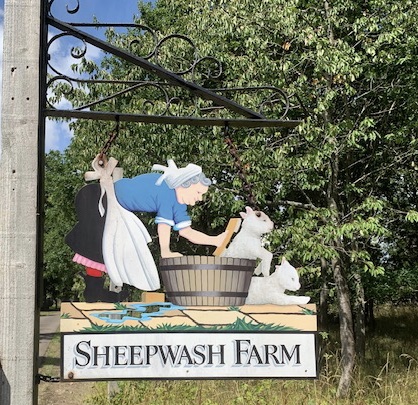 A little further on, after a climb uphill past the tiny, picturesque hamlet of Pythingdean, I was high up on the gallops of Coombelands Equestrian, a cross-country schooling course with over a hundred fences for all standards. I stopped to take a photo of the statue of a smaller than average jockey who stood on a plinth at the Coombelands entrance.
A little further on, after a climb uphill past the tiny, picturesque hamlet of Pythingdean, I was high up on the gallops of Coombelands Equestrian, a cross-country schooling course with over a hundred fences for all standards. I stopped to take a photo of the statue of a smaller than average jockey who stood on a plinth at the Coombelands entrance.
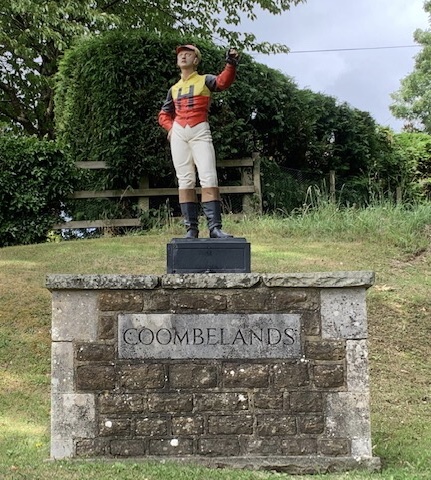 The views from up here were fantastic, taking in the ridge of the South Downs and from here I could see the square church tower in Pulborough down below. Not far to the east of here, at West Chiltington, are the vineyards of Nyetimber which has chosen FSH as one of the five Sussex charities it supports. Nyetimber has generously sponsored our events by supplying its delicious, award-winning sparkling wines and, but for Covid-19, would have hosted a reception for us in May in its magnificent white barn.
The views from up here were fantastic, taking in the ridge of the South Downs and from here I could see the square church tower in Pulborough down below. Not far to the east of here, at West Chiltington, are the vineyards of Nyetimber which has chosen FSH as one of the five Sussex charities it supports. Nyetimber has generously sponsored our events by supplying its delicious, award-winning sparkling wines and, but for Covid-19, would have hosted a reception for us in May in its magnificent white barn.
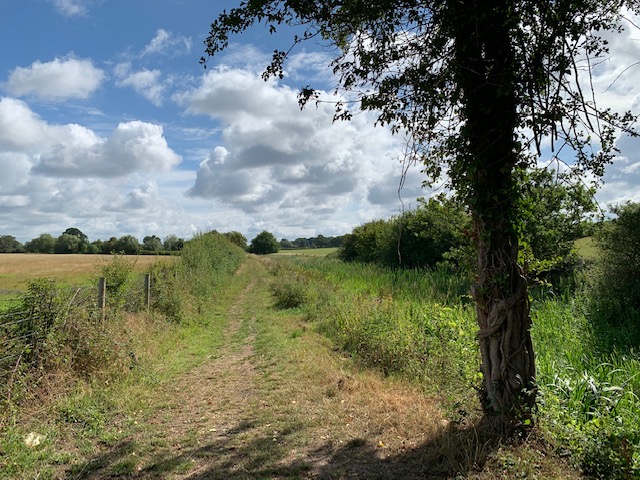 The scenery on this walk was incredibly beautiful – Constable-type scenery – and I once again had the time and space to go within and work on re-centering my own little blue dot.
This section was sponsored by Margaret and Michael Gurney on behalf of The Gurney Charitable Trust. Michael and Margaret are keen walkers who love the Sussex Countryside. Through The Gurney Trust they have been incredibly generous supporters of FSH over many years.
The scenery on this walk was incredibly beautiful – Constable-type scenery – and I once again had the time and space to go within and work on re-centering my own little blue dot.
This section was sponsored by Margaret and Michael Gurney on behalf of The Gurney Charitable Trust. Michael and Margaret are keen walkers who love the Sussex Countryside. Through The Gurney Trust they have been incredibly generous supporters of FSH over many years. 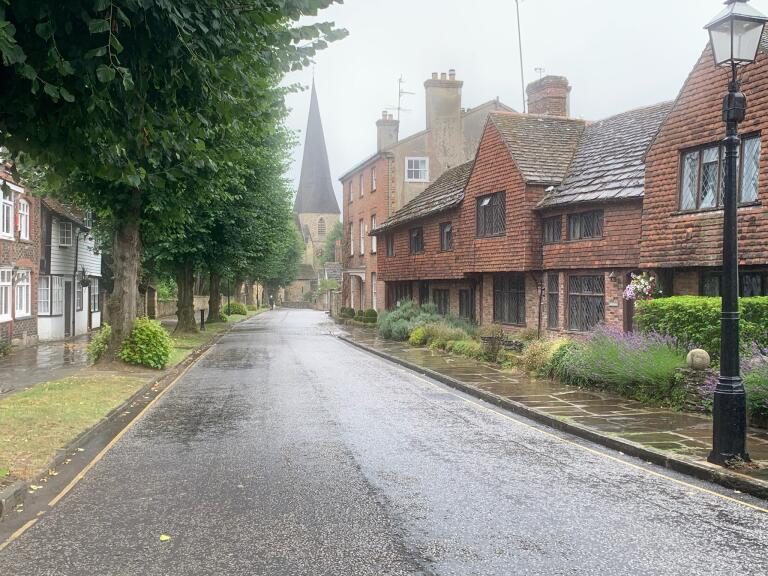 This street, Causeway, led me to the oldest existing building in Horsham, St Mary’s Church. Originally a Norman church stood here and remains of this church are still in evidence. I didn’t go in but walked around its flagstone path to continue my walk. Some of the flagstones were engraved with quotations from the bible – one read: “Where Your Treasure Is, There Your Heart Will Be Also” – Matthew 6:21. This resonated with me. I felt it was asking “what really matters to me?”. This question is integral to the philosophy of hospice care which asks “what matters to you?” rather than “what is the matter with you?”. Excellent meditation fodder……
This street, Causeway, led me to the oldest existing building in Horsham, St Mary’s Church. Originally a Norman church stood here and remains of this church are still in evidence. I didn’t go in but walked around its flagstone path to continue my walk. Some of the flagstones were engraved with quotations from the bible – one read: “Where Your Treasure Is, There Your Heart Will Be Also” – Matthew 6:21. This resonated with me. I felt it was asking “what really matters to me?”. This question is integral to the philosophy of hospice care which asks “what matters to you?” rather than “what is the matter with you?”. Excellent meditation fodder……
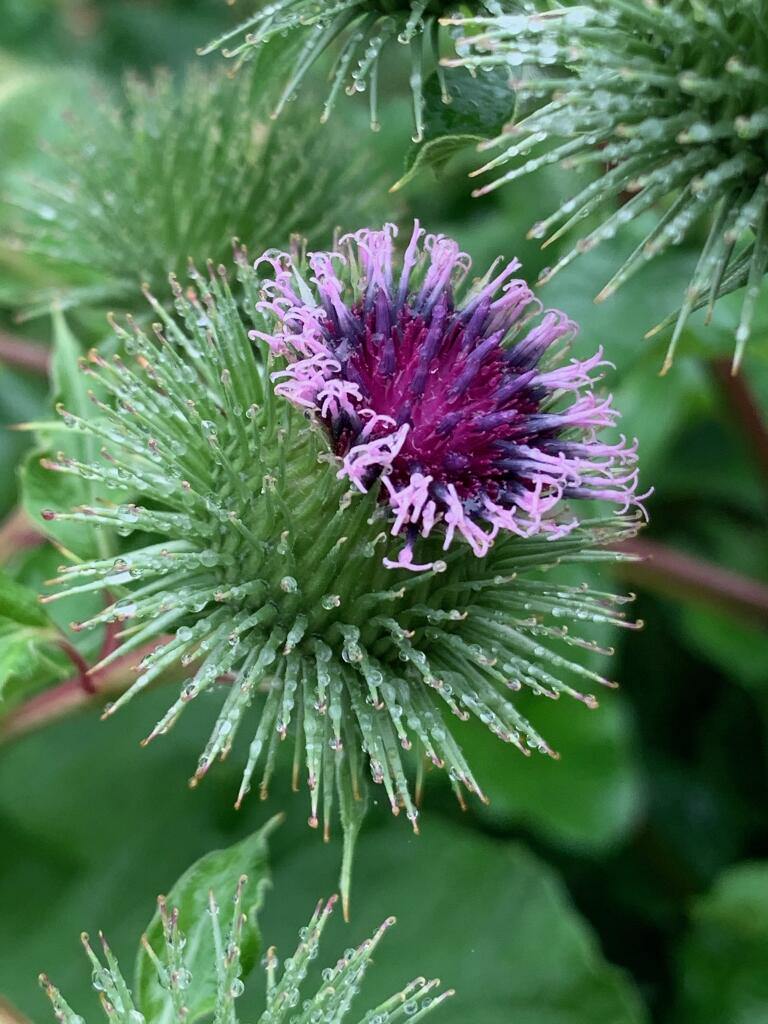 From the rear of the church I crossed the River Arun by a footbridge, walked a short distance through a residential area and crossed the railway line to find myself on a footpath with views of open countryside. It was grey and drizzly and I stopped in a corn field and studied a raindrop on a corn leaf, waiting to see if I could capture it as it fell….. I failed….. I photographed some pretty thistles…….. little wonder my data usage is so high!
From the rear of the church I crossed the River Arun by a footbridge, walked a short distance through a residential area and crossed the railway line to find myself on a footpath with views of open countryside. It was grey and drizzly and I stopped in a corn field and studied a raindrop on a corn leaf, waiting to see if I could capture it as it fell….. I failed….. I photographed some pretty thistles…….. little wonder my data usage is so high!
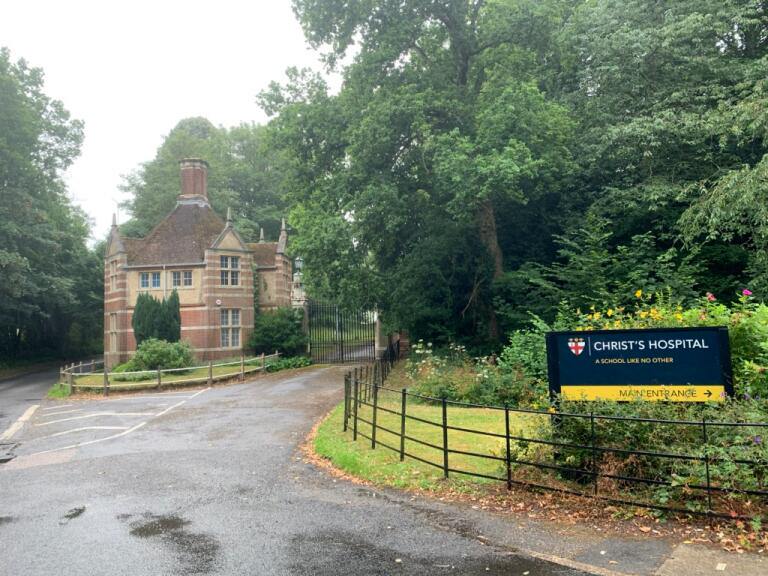 Pretty soon I passed under the A24 and was at Christ’s Hospital, one of the oldest boarding schools in England originally opened, as primarily a charitable institution, in London in 1552 with King Edward VI as its patron and founder. Its pupils are easily recognisable by their Tudor-style uniform – long dark blue belted coat with knee breeches, yellow socks and white neck bands – which has remained virtually unchanged for over 460 years.
Pretty soon I passed under the A24 and was at Christ’s Hospital, one of the oldest boarding schools in England originally opened, as primarily a charitable institution, in London in 1552 with King Edward VI as its patron and founder. Its pupils are easily recognisable by their Tudor-style uniform – long dark blue belted coat with knee breeches, yellow socks and white neck bands – which has remained virtually unchanged for over 460 years.
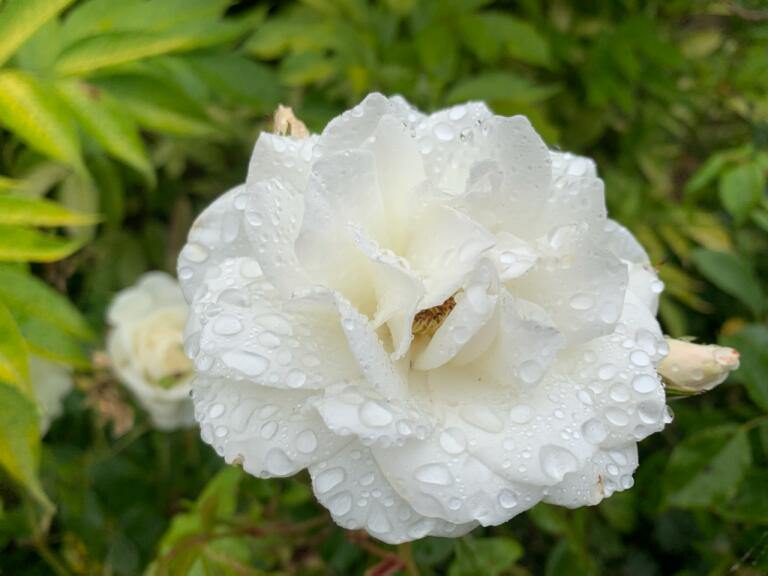 I was last here for one of Andrew Bernardi’s Shipley Arts Festival recitals in the Chapel. Andrew, who lives in nearby Shipley, has been a great supporter of FSH, playing at many of our events on his priceless Stradivarius and auctioning private performances to raise funds for us. His Bernardi Music Group performed a magnificent concert at Goodwood House in 2016 which raised £24,000 for FSH.
I was last here for one of Andrew Bernardi’s Shipley Arts Festival recitals in the Chapel. Andrew, who lives in nearby Shipley, has been a great supporter of FSH, playing at many of our events on his priceless Stradivarius and auctioning private performances to raise funds for us. His Bernardi Music Group performed a magnificent concert at Goodwood House in 2016 which raised £24,000 for FSH.
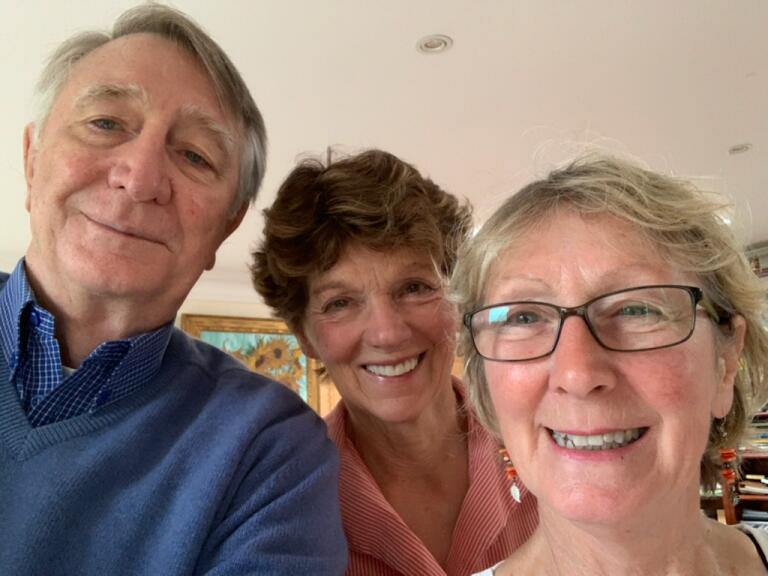 As I walked along the school’s perimeter road I realised that I was crossing the driveway leading to the house of my friends Louise and Roy – so I called in for a pit stop. It was so lovely to see them and catch up over a cup of coffee. Louise and I have run and walked many miles together on the South Downs over the years. Via another of Lisette’s brilliant deviations, Louise accompanied me as far as Itchingfield Church and I continued alone in the direction of Barnes Green which I know well from its Half Marathon which I ran in several years ago.It has a figure-of-eight-course which goes through the grounds of Christ’s Hospital. At this point I figured that somewhere to the north of me was Warnham Park, a 215 acre deer park owned by Jonathan and Caroline Lucas. Jonathan and Caroline have been very generous supporters of FSH, accommodating meetings and hosting a splendid reception for us in their lovely home.
A short distance beyond Barnes Green I walked past The Queens Head pub and through Sumners Ponds Fishery and Campsite. The campsite was quite busy – it brought to mind happy memories of childhood camping holidays – usually at Clacton in Essex. I can’t recall there being any grey drizzly days like this…….. maybe I erased those.
As I walked along the school’s perimeter road I realised that I was crossing the driveway leading to the house of my friends Louise and Roy – so I called in for a pit stop. It was so lovely to see them and catch up over a cup of coffee. Louise and I have run and walked many miles together on the South Downs over the years. Via another of Lisette’s brilliant deviations, Louise accompanied me as far as Itchingfield Church and I continued alone in the direction of Barnes Green which I know well from its Half Marathon which I ran in several years ago.It has a figure-of-eight-course which goes through the grounds of Christ’s Hospital. At this point I figured that somewhere to the north of me was Warnham Park, a 215 acre deer park owned by Jonathan and Caroline Lucas. Jonathan and Caroline have been very generous supporters of FSH, accommodating meetings and hosting a splendid reception for us in their lovely home.
A short distance beyond Barnes Green I walked past The Queens Head pub and through Sumners Ponds Fishery and Campsite. The campsite was quite busy – it brought to mind happy memories of childhood camping holidays – usually at Clacton in Essex. I can’t recall there being any grey drizzly days like this…….. maybe I erased those.
 I continued through a lovely wood, past a field of alpacas and through a very equestrian zone – lots of stables and riders of all ages out and about. On leaving this estate I crossed a stile next to an old fashioned, bright red post box. A little further along I walked directly underneath an electricity pylon and took a dizzy-making photo gazing up through its centre.
I continued through a lovely wood, past a field of alpacas and through a very equestrian zone – lots of stables and riders of all ages out and about. On leaving this estate I crossed a stile next to an old fashioned, bright red post box. A little further along I walked directly underneath an electricity pylon and took a dizzy-making photo gazing up through its centre.
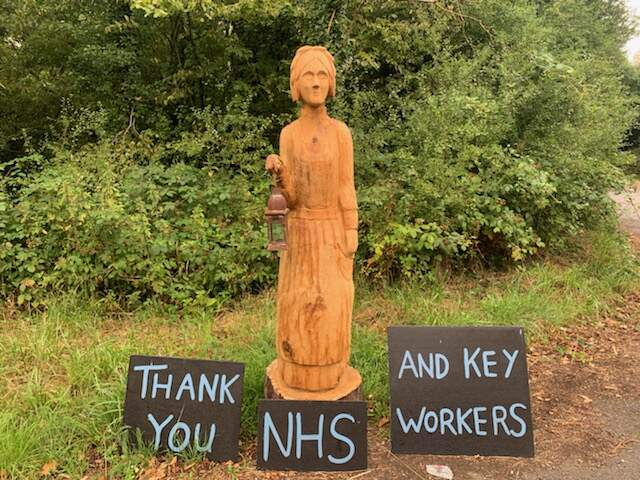 On crossing the A272 I came upon a life size wood carving of Florence Nightingale with her lamp, a shrine of thanks to the NHS and key workers. Under a canopy nearby, its sculptor, chainsaw carver, Gil Parham, was busy working on a beautiful sea horse. I chatted with Gil and helper Richard Hobbs, a local woodsman and coppice worker.
On crossing the A272 I came upon a life size wood carving of Florence Nightingale with her lamp, a shrine of thanks to the NHS and key workers. Under a canopy nearby, its sculptor, chainsaw carver, Gil Parham, was busy working on a beautiful sea horse. I chatted with Gil and helper Richard Hobbs, a local woodsman and coppice worker.
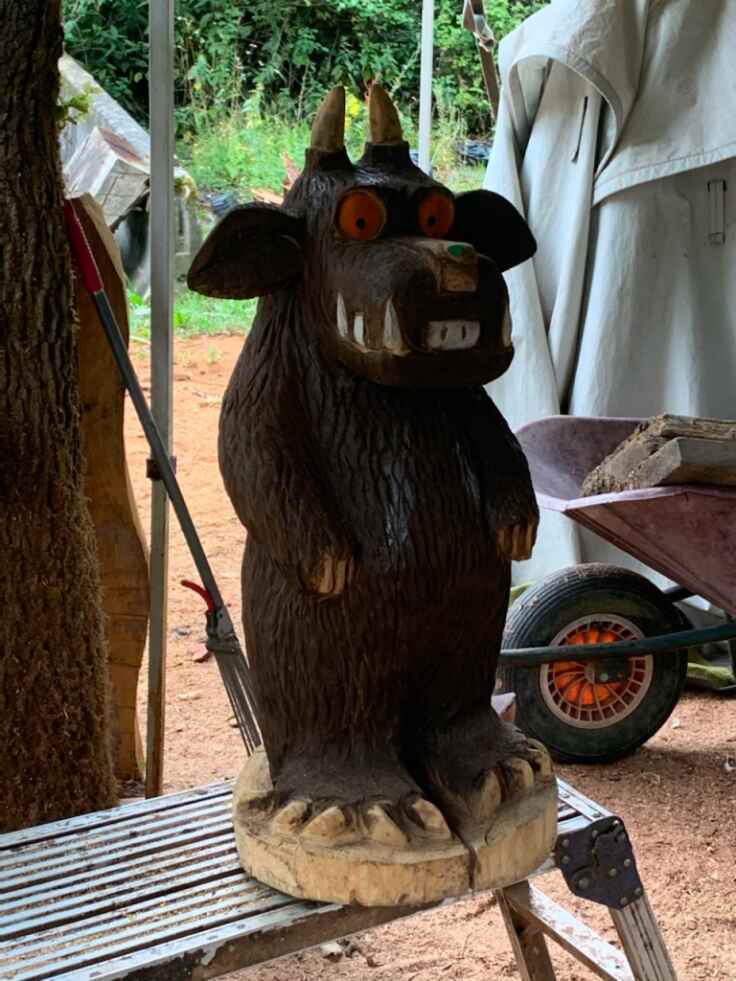 Whilst talking with them my eye caught sight of a Gruffalo – a beautifully carved one – and Gil told me that she carved giant size figures of all of the characters for one of the very early Gruffalo Trail parks.From here it was a short distance to the end of my walk at Billingshurst.
This section of the trail was sponsored in 2016 by Mecmesin Ltd, a Sussex-based manufacturer of testing equipment, thanks to a generous donation by Carolyn Oakley.
Whilst talking with them my eye caught sight of a Gruffalo – a beautifully carved one – and Gil told me that she carved giant size figures of all of the characters for one of the very early Gruffalo Trail parks.From here it was a short distance to the end of my walk at Billingshurst.
This section of the trail was sponsored in 2016 by Mecmesin Ltd, a Sussex-based manufacturer of testing equipment, thanks to a generous donation by Carolyn Oakley. 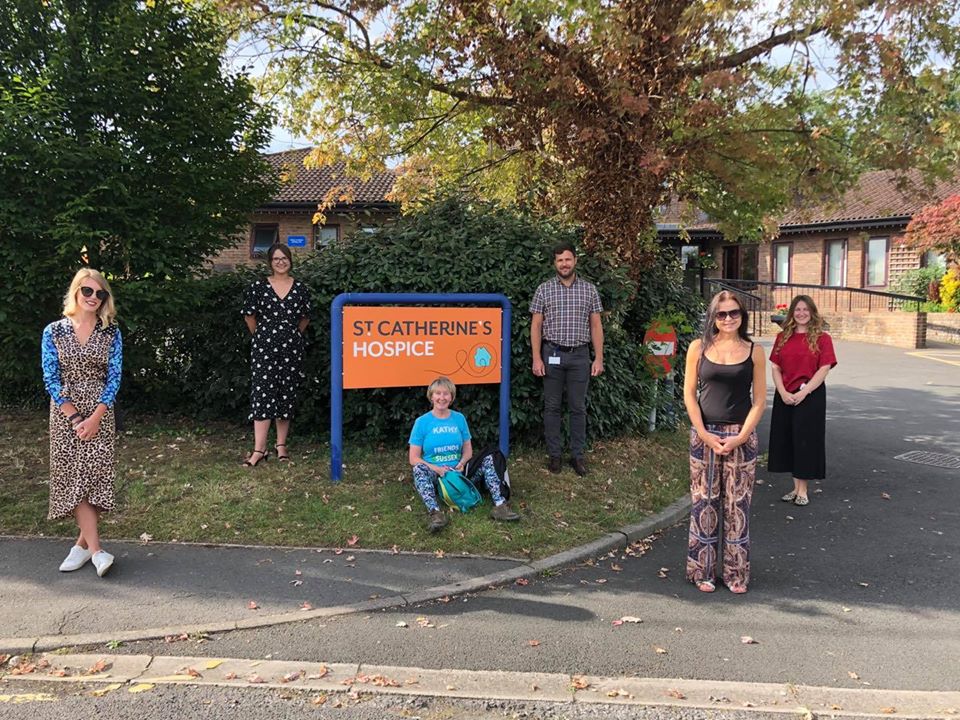 We chatted about the impact Covid-19 has had on the hospice. As with many other hospices, inpatient occupancy was very low in the first few months of the pandemic; there was an increase in care delivered in the community, and a great deal of support given via telephone and video link. Inpatient numbers are returning to normal. Construction of the new hospice building at Pease Pottage, which should have commenced in June, has been delayed until it is deemed sensible to do so. In terms of fundraising – the hospice had an excellent response to its Covid appeal which raised £130k and is about to embark on a second. It costs around £10m a year to run all of St Catherine’s hospice services. A third of this is funded through NHS grants and contracts, with the remaining two-thirds being raised from the local community (shops, fundraising, lottery and legacies).
My day started somewhat disastrously – apart from my visit to St Catherine’s – and continued a little that vein throughout the day. Because I’ve used a huge amount of data on my iPhone – sending photos via text each day – O2 decided I’d gone way over my limit and cut me off!
They’d sent an email warning me and I had paid to cover this, but they still cut me off. This meant I had no means of communication and, much more worrying, no GPS – no ‘little blue dot’ – I could follow. I decided to go ahead armed with the guide notes. I could still take photos on my iPhone – I just couldn’t send them anywhere – and I could use the phone’s compass.
We chatted about the impact Covid-19 has had on the hospice. As with many other hospices, inpatient occupancy was very low in the first few months of the pandemic; there was an increase in care delivered in the community, and a great deal of support given via telephone and video link. Inpatient numbers are returning to normal. Construction of the new hospice building at Pease Pottage, which should have commenced in June, has been delayed until it is deemed sensible to do so. In terms of fundraising – the hospice had an excellent response to its Covid appeal which raised £130k and is about to embark on a second. It costs around £10m a year to run all of St Catherine’s hospice services. A third of this is funded through NHS grants and contracts, with the remaining two-thirds being raised from the local community (shops, fundraising, lottery and legacies).
My day started somewhat disastrously – apart from my visit to St Catherine’s – and continued a little that vein throughout the day. Because I’ve used a huge amount of data on my iPhone – sending photos via text each day – O2 decided I’d gone way over my limit and cut me off!
They’d sent an email warning me and I had paid to cover this, but they still cut me off. This meant I had no means of communication and, much more worrying, no GPS – no ‘little blue dot’ – I could follow. I decided to go ahead armed with the guide notes. I could still take photos on my iPhone – I just couldn’t send them anywhere – and I could use the phone’s compass.
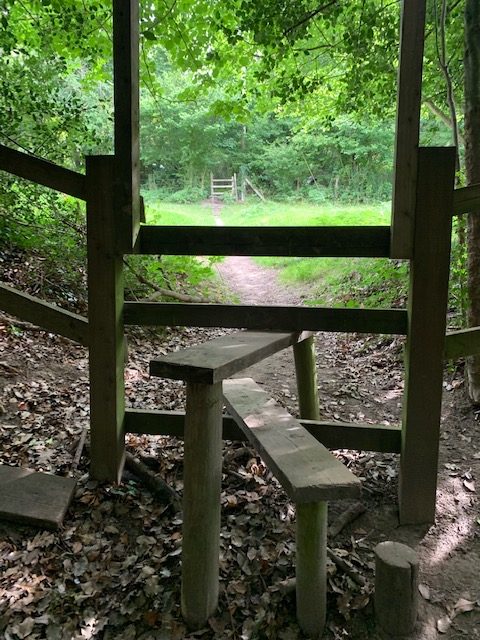 The weather was slightly overcast as I set off from Balcombe Station. I felt excited at the prospect of an adventure and only a smidgen of apprehension over my total lack of sense of direction. I also felt it would give me a good opportunity to really be alone to meditate and clear stuff – O2 had pushed a lot of buttons – so I had plenty to work on.
The weather was slightly overcast as I set off from Balcombe Station. I felt excited at the prospect of an adventure and only a smidgen of apprehension over my total lack of sense of direction. I also felt it would give me a good opportunity to really be alone to meditate and clear stuff – O2 had pushed a lot of buttons – so I had plenty to work on.
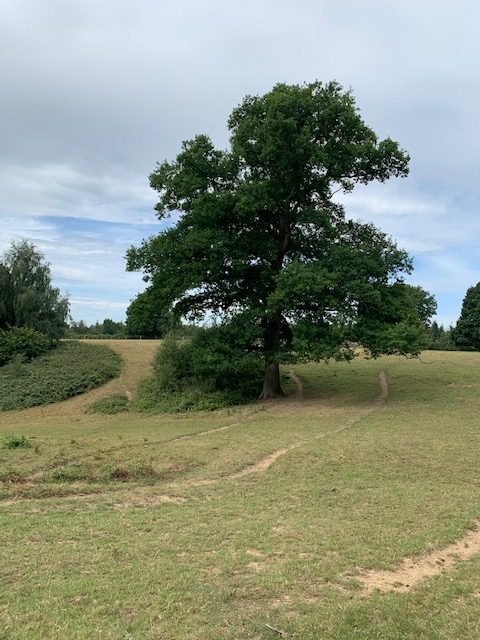 The guide notes promised some great views of the Sussex Weald from the top of the first hill but trees were blocking much of the view – I wondered if, when the walk was being tracked, the trees weren’t in leaf? This was more than compensated for throughout the walk as there were many, many fantastic panoramic vistas.
The guide notes promised some great views of the Sussex Weald from the top of the first hill but trees were blocking much of the view – I wondered if, when the walk was being tracked, the trees weren’t in leaf? This was more than compensated for throughout the walk as there were many, many fantastic panoramic vistas.
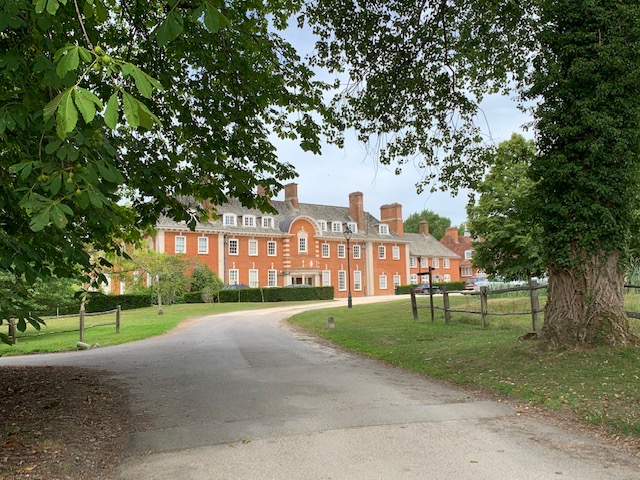 As I progressed I was pleased with how well I was doing, my confidence being boosted by the sight of our green Hospice Trail waymarkers at intervals and the sky was brightening up. I walked through farms, and fields and several very pretty woods and arrived without any problem at Ditton Place, an impressive Grade II listed building built in 1904 for the owner of Prudential Insurance who used the house as a summer residence.
As I progressed I was pleased with how well I was doing, my confidence being boosted by the sight of our green Hospice Trail waymarkers at intervals and the sky was brightening up. I walked through farms, and fields and several very pretty woods and arrived without any problem at Ditton Place, an impressive Grade II listed building built in 1904 for the owner of Prudential Insurance who used the house as a summer residence.
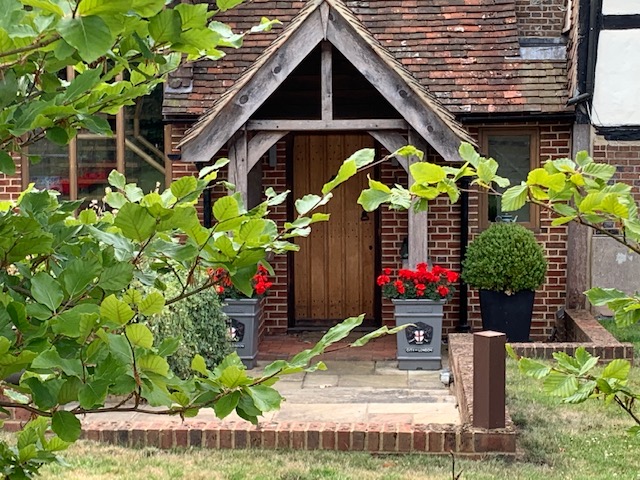 On the edge of the estate was a very pretty house, it’s garden neatly planted with red geraniums. I was fascinated by the ‘City of London’ planters outside the front door – also planted with red geraniums – and wondered who lived there.
On the edge of the estate was a very pretty house, it’s garden neatly planted with red geraniums. I was fascinated by the ‘City of London’ planters outside the front door – also planted with red geraniums – and wondered who lived there.
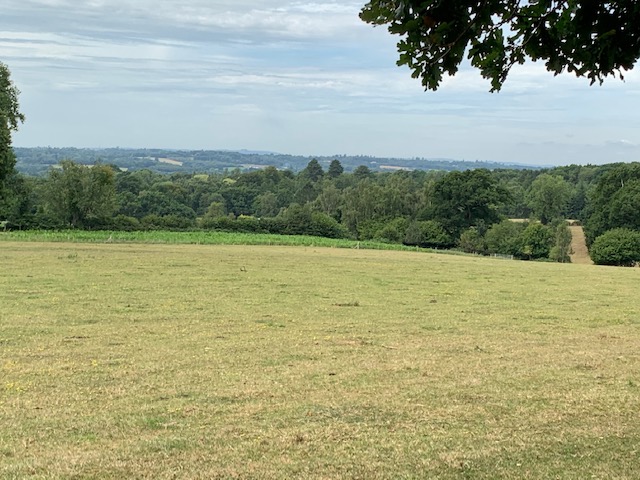 As I continued there were fabulous views across the High Weald – patchworks of greens and golds – truly breathtaking.On entering a delightful wood with the sun was breaking through the canopy in places, it brought to mind happy childhood memories of family outings to Epping Forest – we lived just off the busy Commercial Road/A13 in East London and Epping was only about an hour away.
It was after the next woodland section that I got horribly lost – possibly caused by my misinterpretation of the guide notes. I began to panic a bit and had gone a long way without seeing anything mentioned in the notes or a Trail waymarker and when I referred to my compass it told me I was heading east – 180 degrees in the wrong direction!
I knocked on the door of a cottage but there was no response and then flagged down a van. I explained what I was doing and asked the driver, a lovely man called Tony, if he could direct me to Nyman’s – my next point of reference. He said he’d never heard of Nyman’s as he’d just driven from Bournemouth but his Google map showed that it wasn’t too far away. We agreed the safest bet would be to make my way by the main roads and pick up the Trail from Nyman’s. Before driving off Tony handed me a twenty pound note for FSH – aren’t people wonderful!
This plan meant walking for over a mile along the busy B2114 which had no footpath or pavement….. quite scary in places. Rather stupidly I headed for where the Trail entered Nyman’s rather than where it exited, which meant an interesting but steep walk down through its woods and a very long schlep back up to the top again.
As I continued there were fabulous views across the High Weald – patchworks of greens and golds – truly breathtaking.On entering a delightful wood with the sun was breaking through the canopy in places, it brought to mind happy childhood memories of family outings to Epping Forest – we lived just off the busy Commercial Road/A13 in East London and Epping was only about an hour away.
It was after the next woodland section that I got horribly lost – possibly caused by my misinterpretation of the guide notes. I began to panic a bit and had gone a long way without seeing anything mentioned in the notes or a Trail waymarker and when I referred to my compass it told me I was heading east – 180 degrees in the wrong direction!
I knocked on the door of a cottage but there was no response and then flagged down a van. I explained what I was doing and asked the driver, a lovely man called Tony, if he could direct me to Nyman’s – my next point of reference. He said he’d never heard of Nyman’s as he’d just driven from Bournemouth but his Google map showed that it wasn’t too far away. We agreed the safest bet would be to make my way by the main roads and pick up the Trail from Nyman’s. Before driving off Tony handed me a twenty pound note for FSH – aren’t people wonderful!
This plan meant walking for over a mile along the busy B2114 which had no footpath or pavement….. quite scary in places. Rather stupidly I headed for where the Trail entered Nyman’s rather than where it exited, which meant an interesting but steep walk down through its woods and a very long schlep back up to the top again.
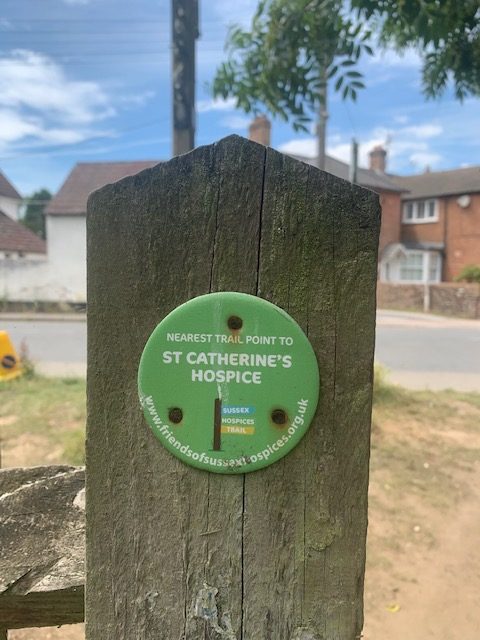 Relieved to be back on track and even more delighted to see the ‘nearest point to St Catherine’s Hospice’ way marker as I left Nyman’s, I headed off in the direction of Carterslodge Pond.
Relieved to be back on track and even more delighted to see the ‘nearest point to St Catherine’s Hospice’ way marker as I left Nyman’s, I headed off in the direction of Carterslodge Pond.
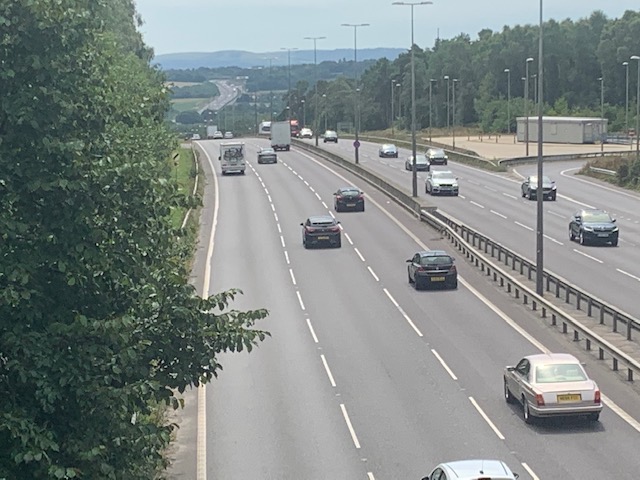 Crossing over the A23 via the B2110 was quite hair raising – I don’t have a good head for heights and the noise and speed of the traffic whizzing by underneath made me feel dizzy.
Crossing over the A23 via the B2110 was quite hair raising – I don’t have a good head for heights and the noise and speed of the traffic whizzing by underneath made me feel dizzy.
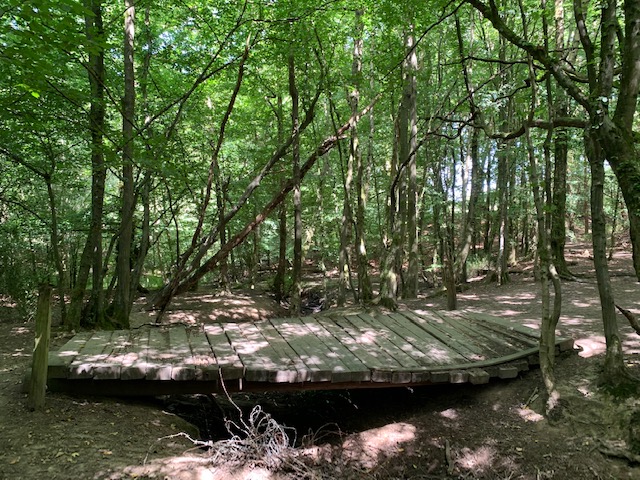 About a mile or so further on I went horribly wrong again – this time, I think, because signage and access to the public footpath had been removed and any trace was now covered in brambles. Using my compass I walked in a westerly direction as best I could. With the help of a cyclist, I eventually found the top of Carterslodge Lane and, at its bottom, Carterslodge Pond, where some major ground works were underway.
After a steady climb up from the pond I was led through a cornfield – with breathtaking views – and into some woods where a large footbridge over a stream had subsided – it was, however, stable enough to cross. From here I entered St Leonard’s Forest, an 85 hectare Forestry Commission-owned site. It’s path was wide and open with people perambulating along it. I was happily back on track, endorsed by a few more Hospice Trail waymarkers.
A woodland path led me out of the forest and onto a wide open space with no sign of the motocross bikes that my guide notes said often use it for racing. A little further on I reached the outskirts of Horsham and after about a mile of urban Horsham, eventually reached the station. It had taken me 6.5 hours and I had walked 14.1 miles (instead of 5.5 hours and 11 miles). I felt absolutely pooped but at the same time relieved and elated that I made it.
This was by far the toughest walk I’ve done on the trail so far, both physically and mentally. It put me outside my comfort zone on several occasions – which forced me to go within and to really feel and clear the feelings and emotions that arose. So it was meant to be. Today’s quote in my Buddhist book of thoughts read: “Western laziness consists of cramming our lives with compulsive activity, so that there is no time at all to confront the real issues”. Today I was given the time and space to do some of that.
About a mile or so further on I went horribly wrong again – this time, I think, because signage and access to the public footpath had been removed and any trace was now covered in brambles. Using my compass I walked in a westerly direction as best I could. With the help of a cyclist, I eventually found the top of Carterslodge Lane and, at its bottom, Carterslodge Pond, where some major ground works were underway.
After a steady climb up from the pond I was led through a cornfield – with breathtaking views – and into some woods where a large footbridge over a stream had subsided – it was, however, stable enough to cross. From here I entered St Leonard’s Forest, an 85 hectare Forestry Commission-owned site. It’s path was wide and open with people perambulating along it. I was happily back on track, endorsed by a few more Hospice Trail waymarkers.
A woodland path led me out of the forest and onto a wide open space with no sign of the motocross bikes that my guide notes said often use it for racing. A little further on I reached the outskirts of Horsham and after about a mile of urban Horsham, eventually reached the station. It had taken me 6.5 hours and I had walked 14.1 miles (instead of 5.5 hours and 11 miles). I felt absolutely pooped but at the same time relieved and elated that I made it.
This was by far the toughest walk I’ve done on the trail so far, both physically and mentally. It put me outside my comfort zone on several occasions – which forced me to go within and to really feel and clear the feelings and emotions that arose. So it was meant to be. Today’s quote in my Buddhist book of thoughts read: “Western laziness consists of cramming our lives with compulsive activity, so that there is no time at all to confront the real issues”. Today I was given the time and space to do some of that.
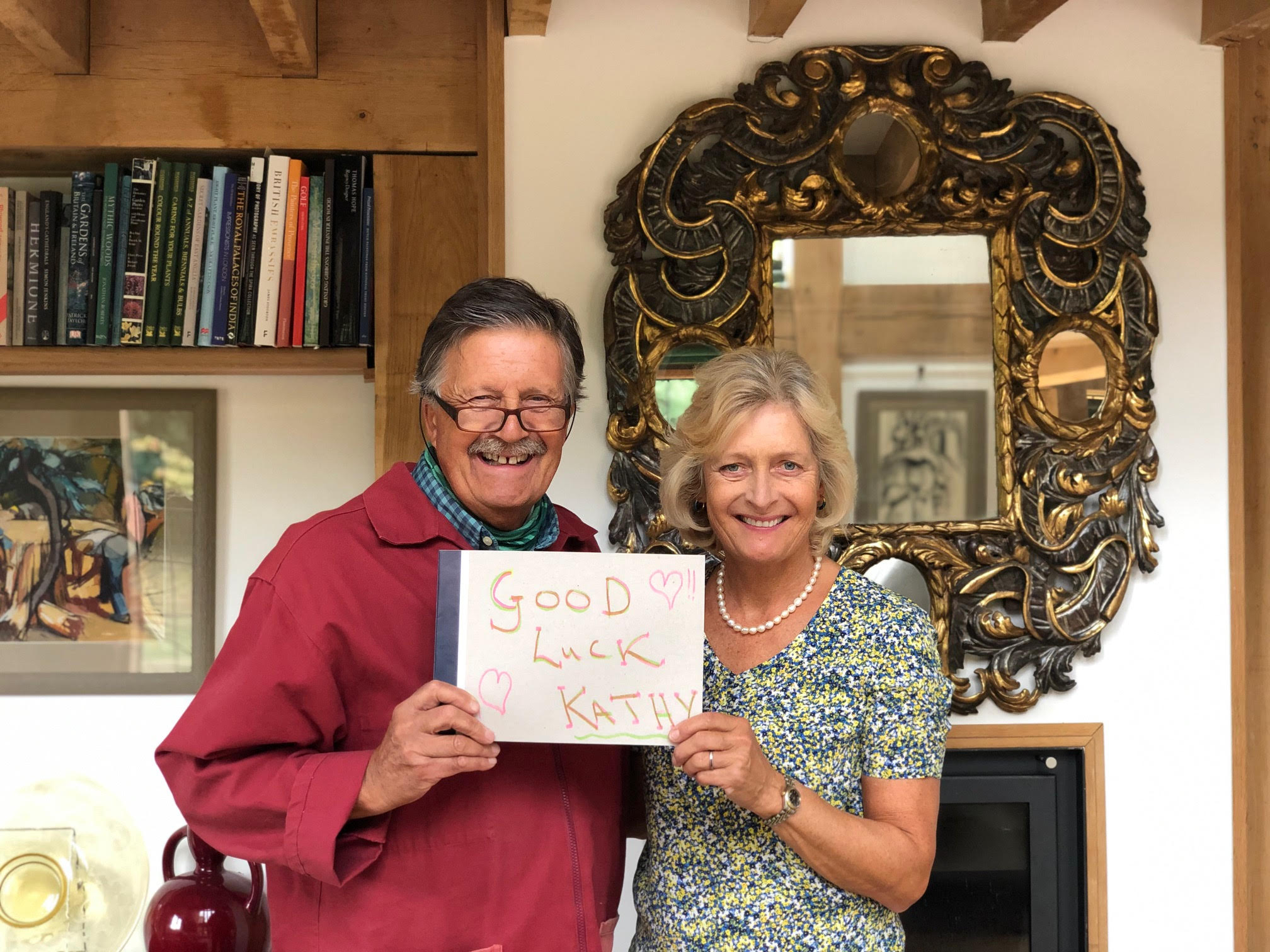 This section of the trail was sponsored by Tim and Helen Wonnacott. Tim is a Patron of FSH and he believes that the many public footpaths in Sussex are one of the great joys of living in this county. I couldn’t agree more!
This section of the trail was sponsored by Tim and Helen Wonnacott. Tim is a Patron of FSH and he believes that the many public footpaths in Sussex are one of the great joys of living in this county. I couldn’t agree more! 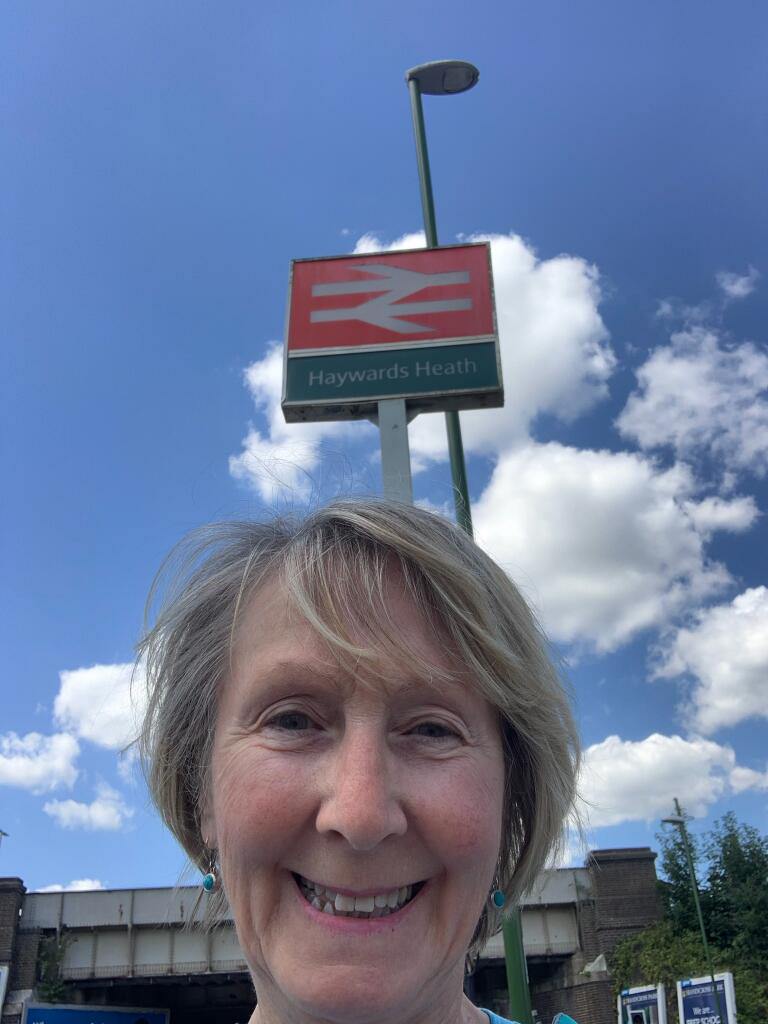 Haywards Heath station was pretty quiet for a midweek morning but the traffic was busy as I headed up towards the golf course. Within minutes I’d left the town and the traffic and was on a pleasant woodland path. There were a few golfers on the course – the greens were pristine, they looked as if they’d just been hoovered.
Haywards Heath station was pretty quiet for a midweek morning but the traffic was busy as I headed up towards the golf course. Within minutes I’d left the town and the traffic and was on a pleasant woodland path. There were a few golfers on the course – the greens were pristine, they looked as if they’d just been hoovered.
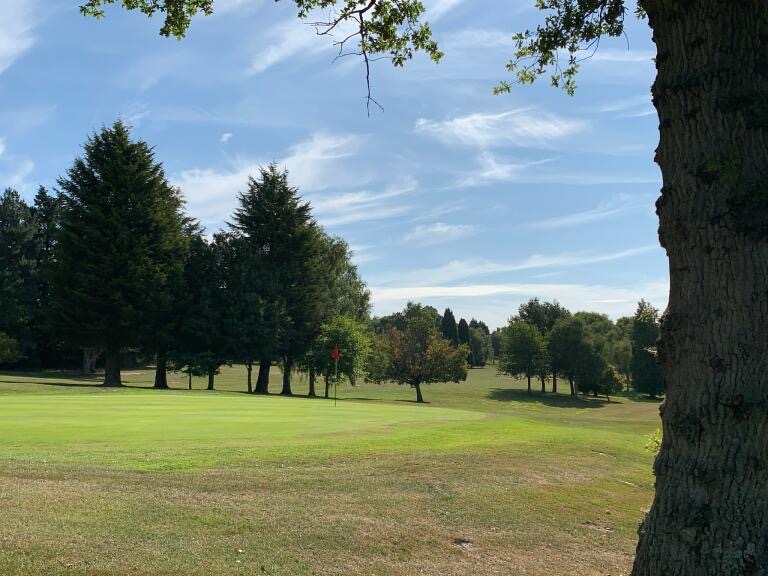 I walked this part of the trail four years ago with a group led by Michael and Alison Brown, who sponsored this section.
I walked this part of the trail four years ago with a group led by Michael and Alison Brown, who sponsored this section.
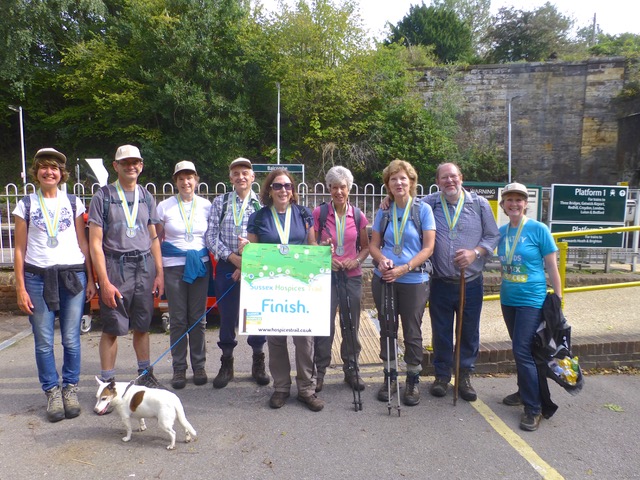 The walk took me through some beautiful scenery, through fields and woods and across some pretty streams and the River Ouse. One field gate sign indicated a bull was in residence – he wasn’t.
The walk took me through some beautiful scenery, through fields and woods and across some pretty streams and the River Ouse. One field gate sign indicated a bull was in residence – he wasn’t.
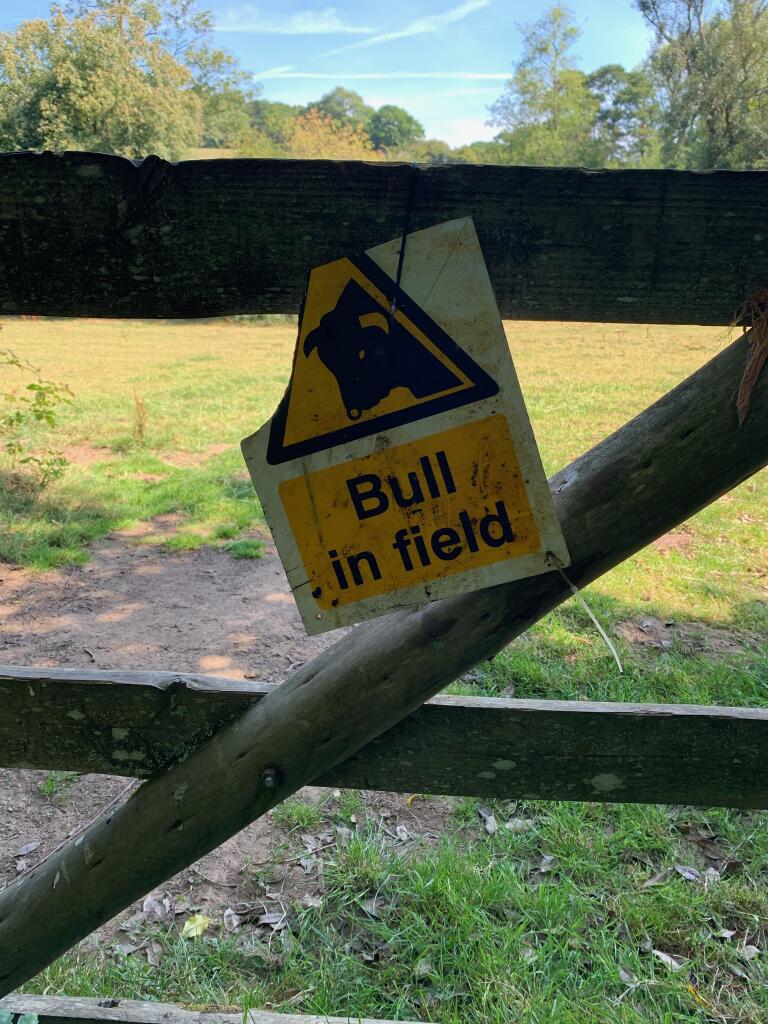 I’d recently been told that one had a better chance of escaping the charge of a bull than that of a cow because bulls lower their heads and charge with their horns so you are not in their line of vision and can run, but cows keep you in their sights as they charge. I’m glad I didn’t have to put the theory to the test!
I’d recently been told that one had a better chance of escaping the charge of a bull than that of a cow because bulls lower their heads and charge with their horns so you are not in their line of vision and can run, but cows keep you in their sights as they charge. I’m glad I didn’t have to put the theory to the test!
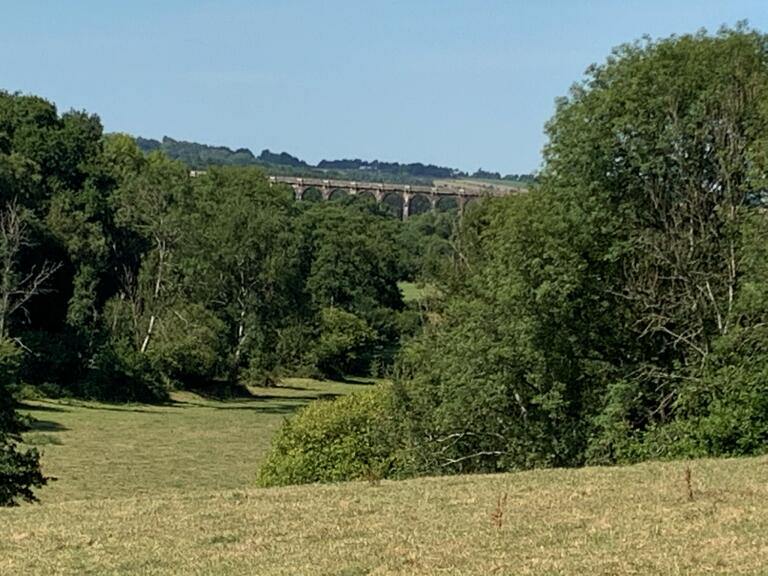 One field, after a steady climb, afforded a fabulous view of the Ouse Valley Viaduct on one side and of Ardingly College on the other.
One field, after a steady climb, afforded a fabulous view of the Ouse Valley Viaduct on one side and of Ardingly College on the other.
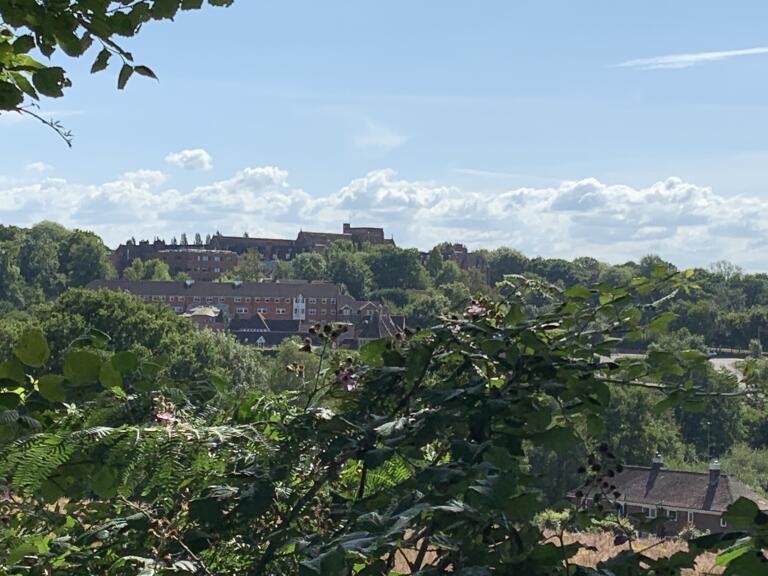 The South of England Showground at Ardingly has been the venue for FSH’s Christmas Fair over many years – sadly, due to Covid-19 the decision has been made to cancel it this year. This will be the first year since the charity was founded 25 years ago, that we won’t be organising one.
The South of England Showground at Ardingly has been the venue for FSH’s Christmas Fair over many years – sadly, due to Covid-19 the decision has been made to cancel it this year. This will be the first year since the charity was founded 25 years ago, that we won’t be organising one.
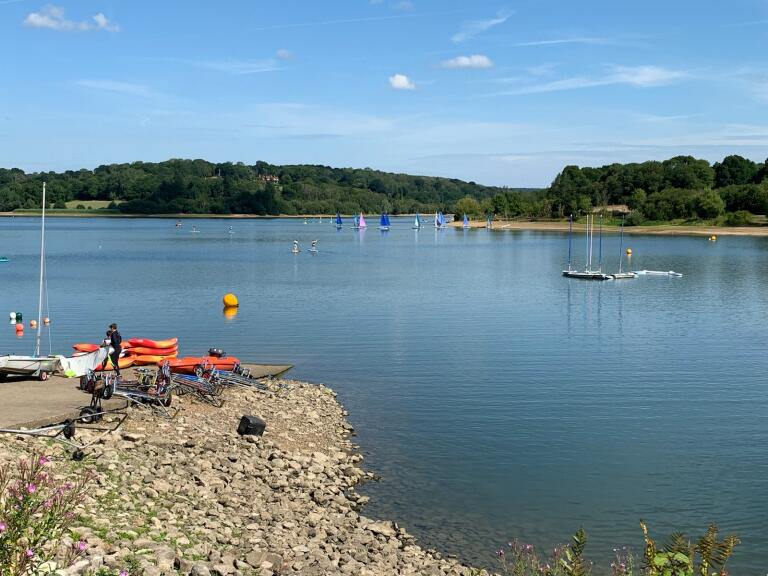 After another field and footpath I emerged at the southerly corner or Ardingly Reservoir. There were groups of young people in wetsuits at the Activity Centre surrounded by colourful water sports paraphernalia.
After another field and footpath I emerged at the southerly corner or Ardingly Reservoir. There were groups of young people in wetsuits at the Activity Centre surrounded by colourful water sports paraphernalia.
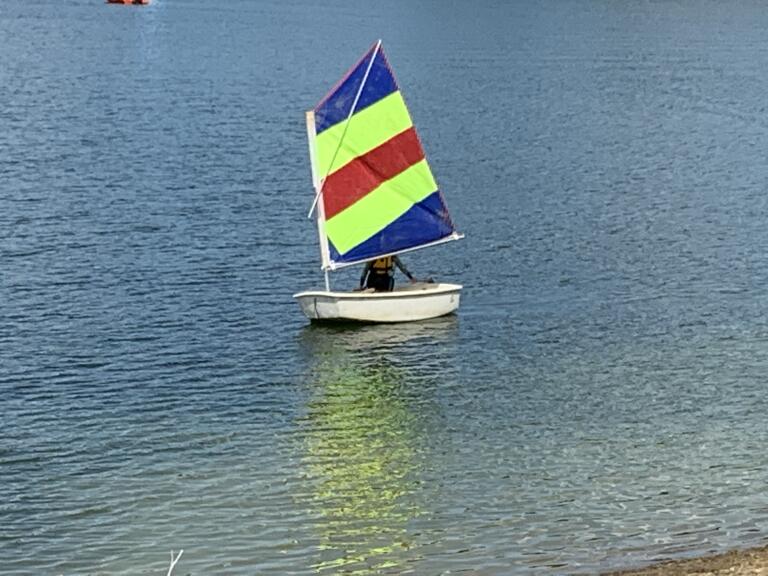 On the water little fleets of sailing dinghies were being brought to order by instructors in boats with engines. It was a lovely sight to behold, especially on such a lovely sunny day. There were little beaches where people were swimming and picnicking.
On the water little fleets of sailing dinghies were being brought to order by instructors in boats with engines. It was a lovely sight to behold, especially on such a lovely sunny day. There were little beaches where people were swimming and picnicking.
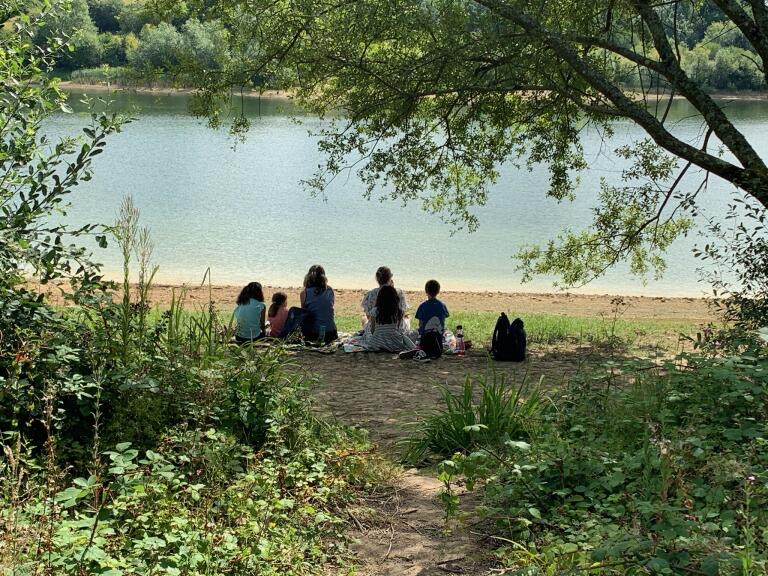 Ardingly Reservoir is designated as a Local Nature Reserve and is home to a great number of bird species – it has two bird hides on the east bank which I walked along. The trail took me up to the northern end of the reservoir and to Balcombe Mill, an attractive Grade II listed building. A steepish climb and a few fields on brought me into the residential outskirts of Balcombe and on to Balcombe station.
Not far from here is Balcombe Place, a Grade II listed country house built in 1856, the venue for a splendid reception for FSH’s corporate supporters in 2019 thanks to the generous hospitality of owners, Fo and Charlie Martin.
Ardingly Reservoir is designated as a Local Nature Reserve and is home to a great number of bird species – it has two bird hides on the east bank which I walked along. The trail took me up to the northern end of the reservoir and to Balcombe Mill, an attractive Grade II listed building. A steepish climb and a few fields on brought me into the residential outskirts of Balcombe and on to Balcombe station.
Not far from here is Balcombe Place, a Grade II listed country house built in 1856, the venue for a splendid reception for FSH’s corporate supporters in 2019 thanks to the generous hospitality of owners, Fo and Charlie Martin.
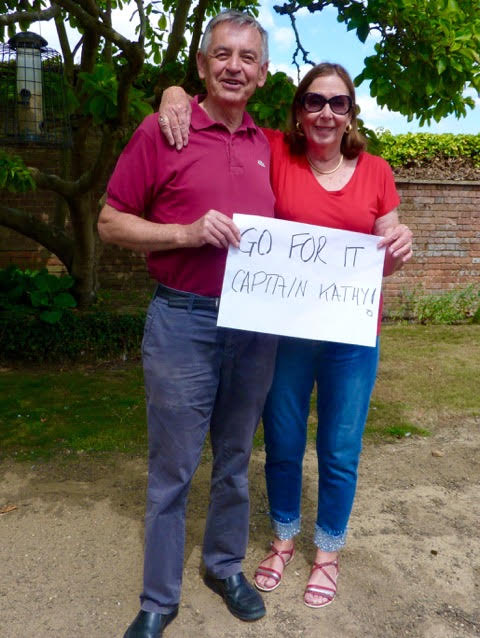 My thanks to longstanding supporters of FSH, Michael and Alison Brown who generously sponsored this section of the Trail.
My thanks to longstanding supporters of FSH, Michael and Alison Brown who generously sponsored this section of the Trail.
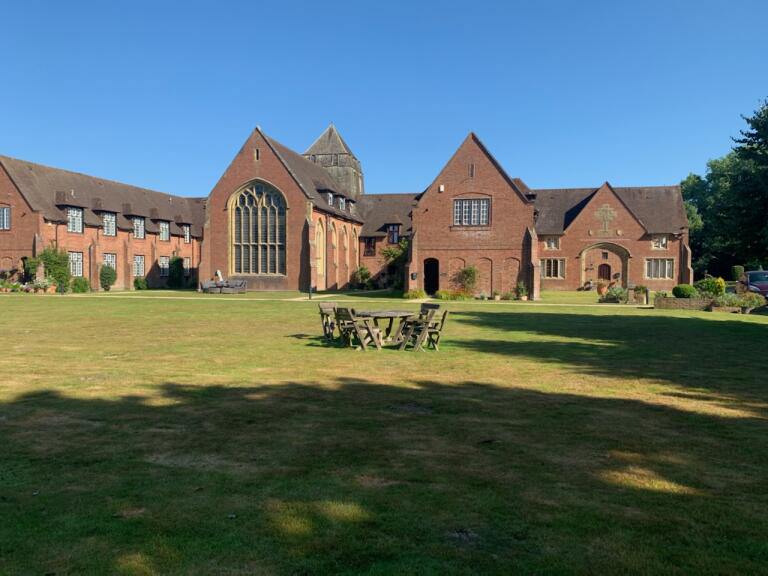 Next to it sits Chailey Windmill. I learned from my guide notes that there has been a mill located here since 1595 and the yew tree, which stands at its side, is said to mark the centre of the historic county of Sussex.
Next to it sits Chailey Windmill. I learned from my guide notes that there has been a mill located here since 1595 and the yew tree, which stands at its side, is said to mark the centre of the historic county of Sussex.
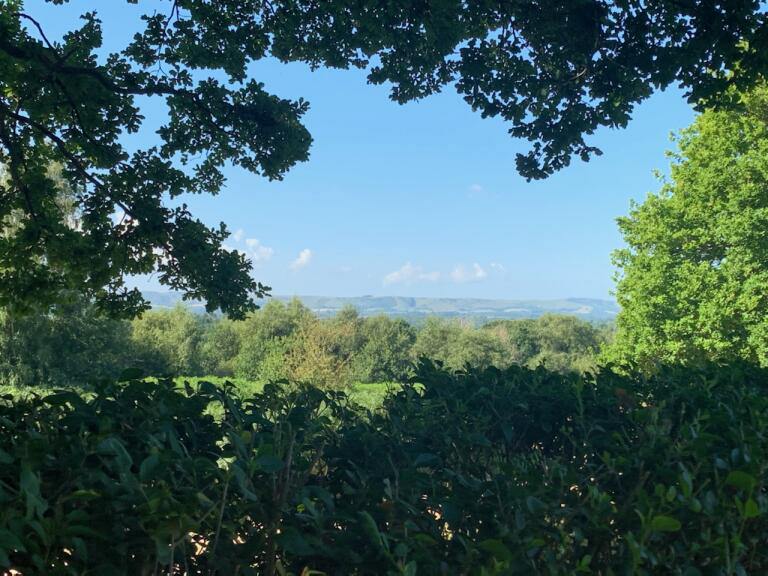 The views from up here are stunning, particularly on such a clear day as this. It was very peaceful – hard to believe that there were so many thousands of people living within just a few miles.
FSH supporters in this area include Cumnor House School, which hosted a fabulous musical evening for us in 2016. The line up included Katie Derham who lives locally, opera stars Felicity Lott, Sally Matthews and Jean Rigby and a very talented young choral group Viva Voce. Another significant FSH supporter is the family-run funeral directors, C.P.J. Field. As well as generously sponsoring events, its offices near Burgess Hill have become the nerve centre for our annual Walk The Hospice Trail Event which Charlie Field and his colleague, Bill Scott, organise with the precision of a military operation. Also not too far away, at Hurstpierpoint, is Danny House, a magnificent Grade I listed Elizabethan red brick Mansion, now comprising prestigious retirement apartments. It’s owner, Richard Burrows, has generously hosted FSH meetings and envelope stuffing days as well as Festival 21, a memorable celebration of our 21st Anniversary.
The views from up here are stunning, particularly on such a clear day as this. It was very peaceful – hard to believe that there were so many thousands of people living within just a few miles.
FSH supporters in this area include Cumnor House School, which hosted a fabulous musical evening for us in 2016. The line up included Katie Derham who lives locally, opera stars Felicity Lott, Sally Matthews and Jean Rigby and a very talented young choral group Viva Voce. Another significant FSH supporter is the family-run funeral directors, C.P.J. Field. As well as generously sponsoring events, its offices near Burgess Hill have become the nerve centre for our annual Walk The Hospice Trail Event which Charlie Field and his colleague, Bill Scott, organise with the precision of a military operation. Also not too far away, at Hurstpierpoint, is Danny House, a magnificent Grade I listed Elizabethan red brick Mansion, now comprising prestigious retirement apartments. It’s owner, Richard Burrows, has generously hosted FSH meetings and envelope stuffing days as well as Festival 21, a memorable celebration of our 21st Anniversary.
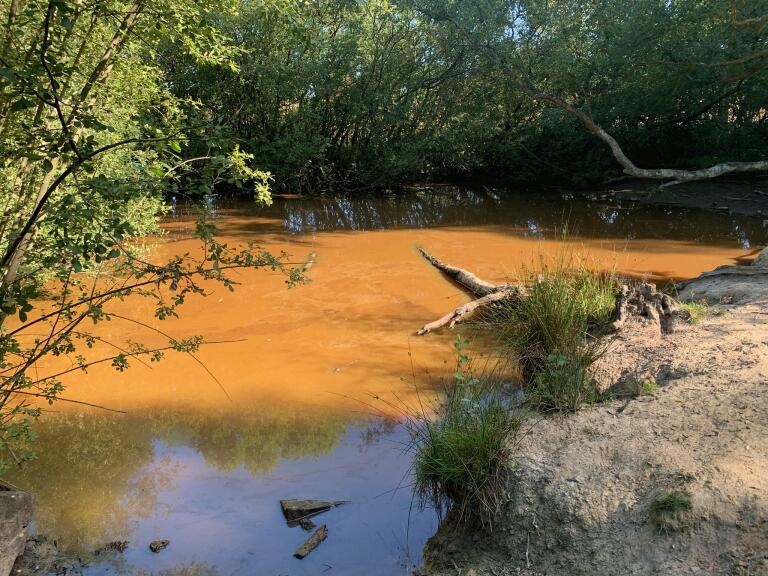 The trail from St George’s led me on to Red House Common and down through a wood to a very sludgy brown pond – I almost expected an alligator to emerge from it.
The trail from St George’s led me on to Red House Common and down through a wood to a very sludgy brown pond – I almost expected an alligator to emerge from it.
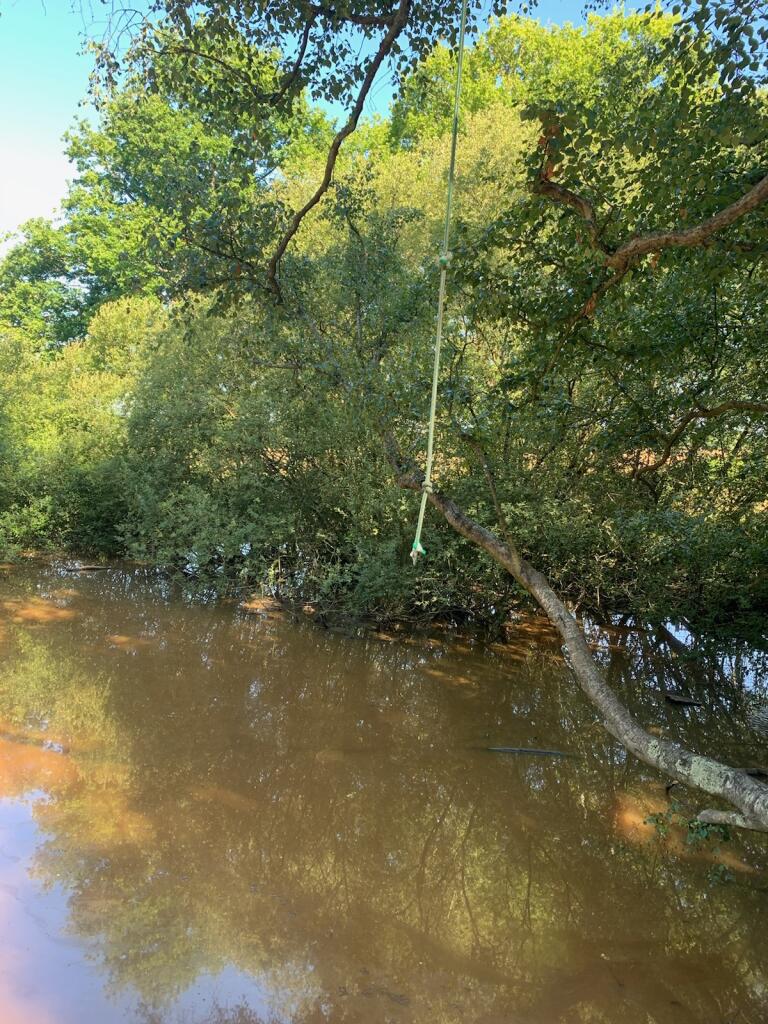 There was a rope dangling from a tree over the pond which looked as though it might have had a tyre hanging from it, but no sign of anyone in distress – it reminded me of this Larson cartoon which I have on my fridge.
There was a rope dangling from a tree over the pond which looked as though it might have had a tyre hanging from it, but no sign of anyone in distress – it reminded me of this Larson cartoon which I have on my fridge.
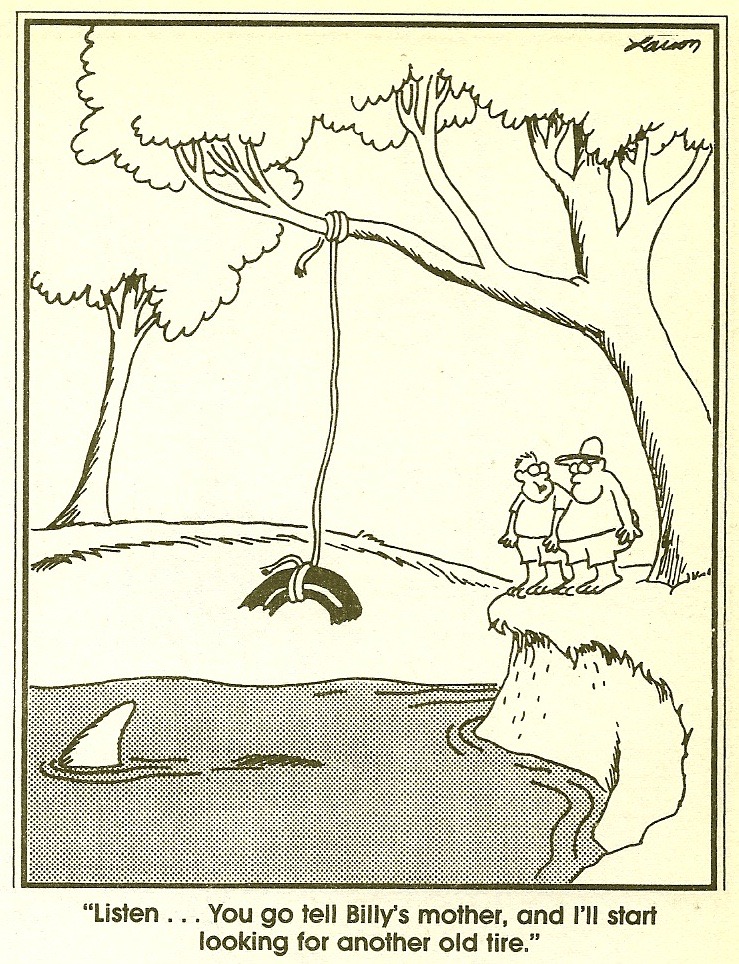 The walk took me through fields and meadows and woodland paths bringing me back to the A272 at Scaynes Hill, then into Church Road and the Grade II listed St Augustine’s Church.
The walk took me through fields and meadows and woodland paths bringing me back to the A272 at Scaynes Hill, then into Church Road and the Grade II listed St Augustine’s Church.
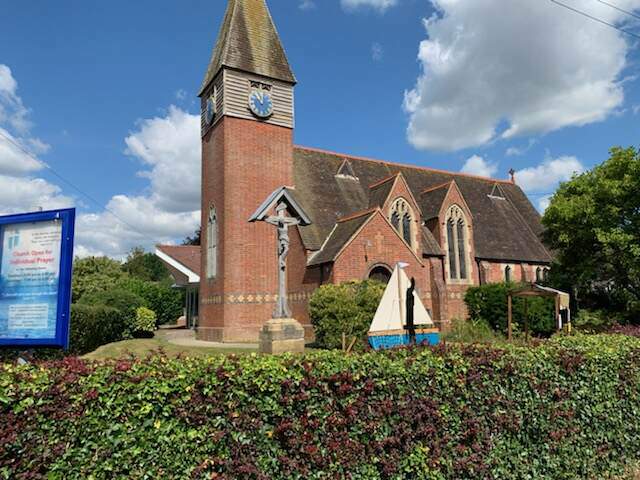 I went inside, it is neither very old nor very special architecturally, but it felt cheerful and warm. It had an interesting, huge tapestry depicting various miracles performed by Jesus, and two attractive stained glass windows.
I went inside, it is neither very old nor very special architecturally, but it felt cheerful and warm. It had an interesting, huge tapestry depicting various miracles performed by Jesus, and two attractive stained glass windows.
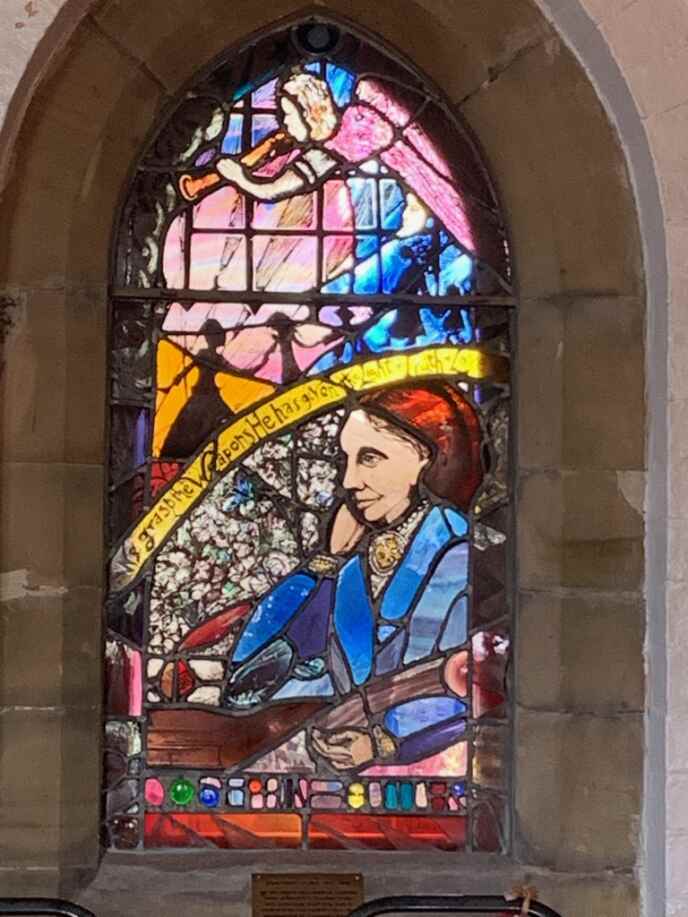 Outside I continued along Church Road and then through Costell’s Wood. At the bottom of the wood there were a dozen or so small children obviously having a whale of a time, clambering over an obstacle course of fallen trees. They were from Kiddie Capers Nursery & Preschool in Scaynes Hill and were being closely supervised by Naomi and her two colleagues.
Outside I continued along Church Road and then through Costell’s Wood. At the bottom of the wood there were a dozen or so small children obviously having a whale of a time, clambering over an obstacle course of fallen trees. They were from Kiddie Capers Nursery & Preschool in Scaynes Hill and were being closely supervised by Naomi and her two colleagues.
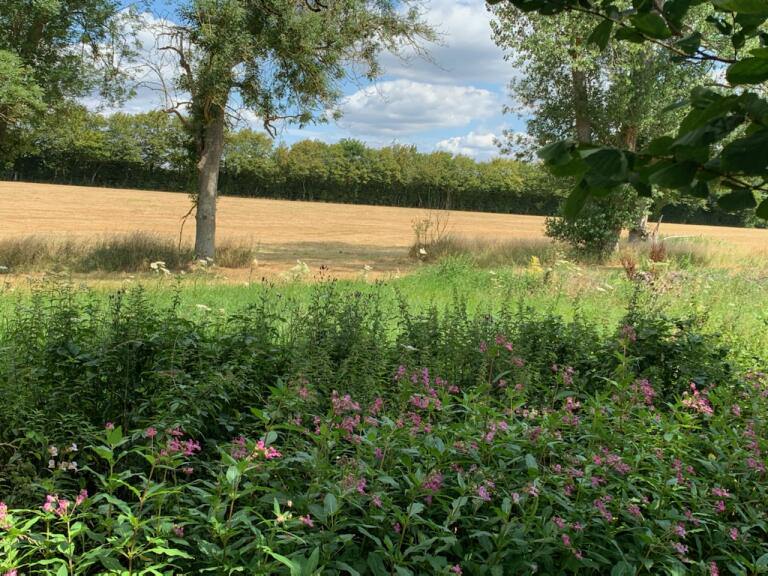 On leaving the wood I managed to get in a complete muddle here as the guide notes didn’t appear to marry up with where my little blue dot was telling me to go, so I went round in circles for a bit.
A few crop fields later I was in Lindfield’s picturesque High Street. From here the walk was through residential areas that linked Lindfield to the suburbs of Haywards Heath.
The creation of this stretch of the trail was possible thanks to David and Peta Crowther, generous supporters of FSH, who live near this part of the trail.
On leaving the wood I managed to get in a complete muddle here as the guide notes didn’t appear to marry up with where my little blue dot was telling me to go, so I went round in circles for a bit.
A few crop fields later I was in Lindfield’s picturesque High Street. From here the walk was through residential areas that linked Lindfield to the suburbs of Haywards Heath.
The creation of this stretch of the trail was possible thanks to David and Peta Crowther, generous supporters of FSH, who live near this part of the trail. 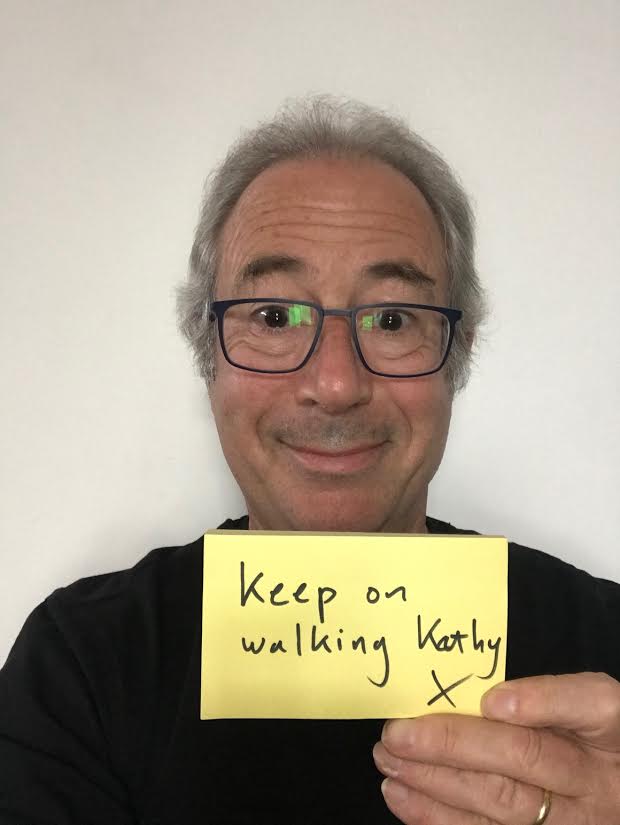 Ben has compered two very successful Summer Concerts for FSH and promoted the cause on radio.
Another beautiful morning – clear blue sky, not too hot, perfect walking weather. I set off from Uckfield Bus Station after being greeted and interviewed there by Mike Skinner for Uckfield FM. The local radio station is a wonderful supporter of FSH and has always been very generous in giving me air time to raise awareness about hospice care and promote our fundraising events.
Ben has compered two very successful Summer Concerts for FSH and promoted the cause on radio.
Another beautiful morning – clear blue sky, not too hot, perfect walking weather. I set off from Uckfield Bus Station after being greeted and interviewed there by Mike Skinner for Uckfield FM. The local radio station is a wonderful supporter of FSH and has always been very generous in giving me air time to raise awareness about hospice care and promote our fundraising events.
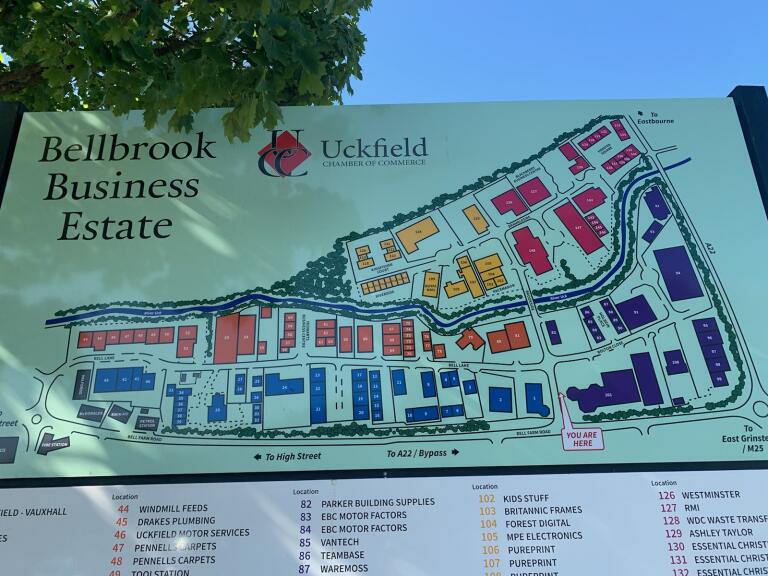 Walking through the Bellbrook Business Estate – one or two units were quiet but on the whole it appeared to be business as usual. About two thirds of the way along the estate the delicious aroma of bacon wafted towards me from Mandy’s Snack Van. I stopped and chatted briefly to Avanda and Daisy, the instigators of this aroma, who kindly offered me some refreshments which I politely declined, fighting an inner voice that was just crying out for a bacon sarni.
Walking through the Bellbrook Business Estate – one or two units were quiet but on the whole it appeared to be business as usual. About two thirds of the way along the estate the delicious aroma of bacon wafted towards me from Mandy’s Snack Van. I stopped and chatted briefly to Avanda and Daisy, the instigators of this aroma, who kindly offered me some refreshments which I politely declined, fighting an inner voice that was just crying out for a bacon sarni.
 Uckfield is my local town so I feel I know it and many of the businesses there well. Just walking through the Business Estate I saw many companies that have supported FSH over many years. FSH is a member of the Uckfield Chamber of Commerce which, as a group, has been hugely supportive.
Uckfield is my local town so I feel I know it and many of the businesses there well. Just walking through the Business Estate I saw many companies that have supported FSH over many years. FSH is a member of the Uckfield Chamber of Commerce which, as a group, has been hugely supportive.
 Having crossed the very busy A22 and a stile, I found myself in a lush green field – such a contrast to the busy industrial/commercial estate I left moments before, the only reminder being the hum of heavy traffic.
Having crossed the very busy A22 and a stile, I found myself in a lush green field – such a contrast to the busy industrial/commercial estate I left moments before, the only reminder being the hum of heavy traffic.
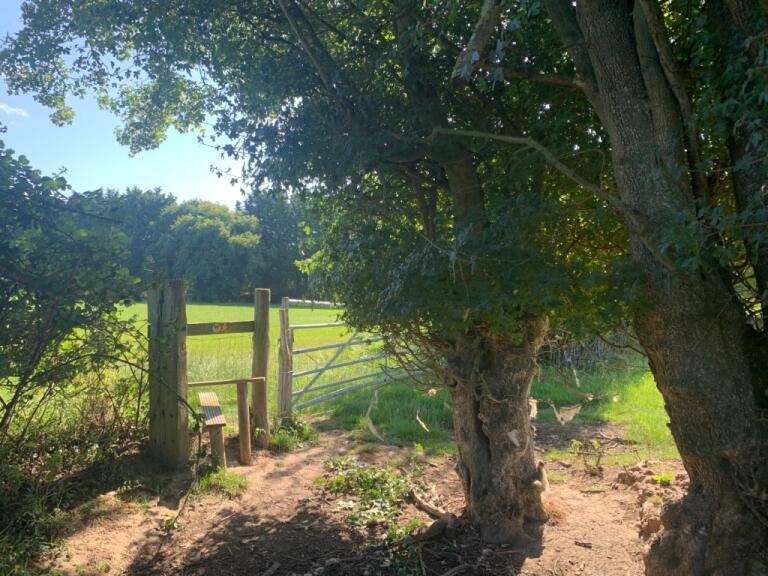 Although relatively well trodden, the paths between the fields here were quite overgrown with bracken, brambles and nettles. I started out taking a walking stick on my walks but found it cumbersome and I can’t say I’ve needed one until now.
This part might possibly be more overgrown by the time of the Walk the Hospice Trail event in October so I made a note to alert walkers on this section to bring a stick ….. and avoid wearing shorts!
Although relatively well trodden, the paths between the fields here were quite overgrown with bracken, brambles and nettles. I started out taking a walking stick on my walks but found it cumbersome and I can’t say I’ve needed one until now.
This part might possibly be more overgrown by the time of the Walk the Hospice Trail event in October so I made a note to alert walkers on this section to bring a stick ….. and avoid wearing shorts!
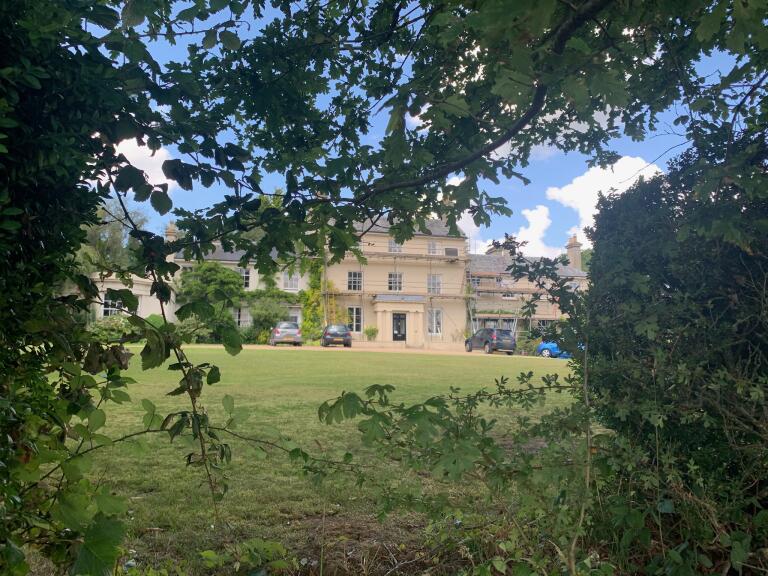 The scenery around Buckham Hill was stunning and I passed through fields of corn, barley, wheat and broad beans.
The scenery around Buckham Hill was stunning and I passed through fields of corn, barley, wheat and broad beans.
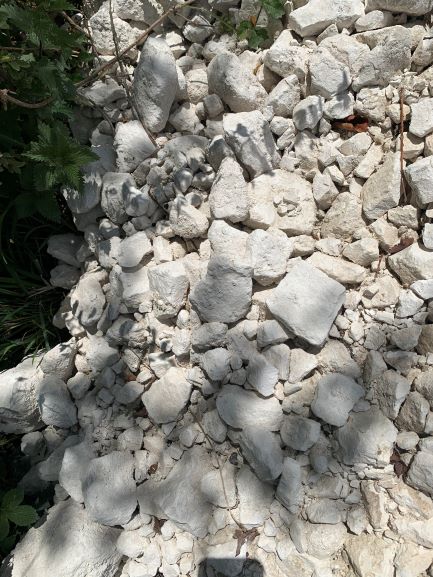 Whilst walking on a chalk path around a field I thought how precious the lumps of chalk on the path edges would have been to me as a child. We were always desperate for chalk, often using crumbling red brick, to draw out our hopscotch lines on the tarmac yard.
Whilst walking on a chalk path around a field I thought how precious the lumps of chalk on the path edges would have been to me as a child. We were always desperate for chalk, often using crumbling red brick, to draw out our hopscotch lines on the tarmac yard.
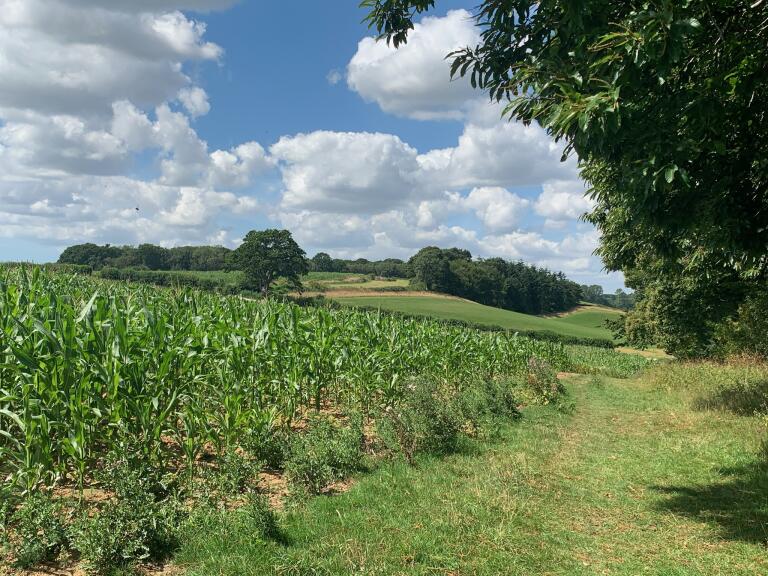 Walking across a meadow just after Buckham Hill, clouds of grasshoppers shot into the air with every step I took – there must have been thousands of them. There were also lots of different butterflies and one very pretty pair twirled and danced ahead of me as I walked. Grasshoppers and butterflies are very difficult to capture on film – even when I thought I’d got a decent shot of some, the result just looked like a bunch of haystalks, so well camouflaged were they.
Walking across a meadow just after Buckham Hill, clouds of grasshoppers shot into the air with every step I took – there must have been thousands of them. There were also lots of different butterflies and one very pretty pair twirled and danced ahead of me as I walked. Grasshoppers and butterflies are very difficult to capture on film – even when I thought I’d got a decent shot of some, the result just looked like a bunch of haystalks, so well camouflaged were they.
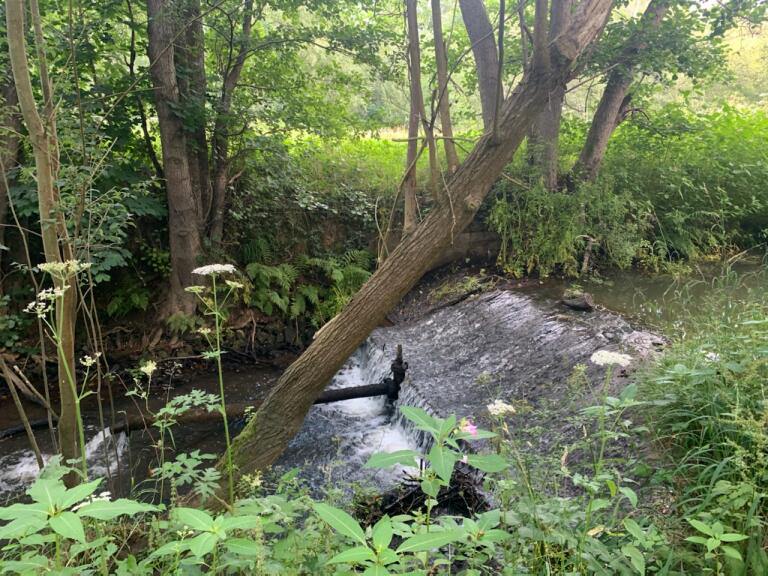 Further along I stopped to watch a weir in a tree shaded part of the River Ouse. The path ran alongside the river for a short way and on parting from it led me into a heavenly golden meadow. The warmth of the sun felt good after the cool shade. I thought about how people used to walk everywhere before the invention of bicycles and motor cars – unless you were wealthy enough to possess a horse. I remember reading the diary of Thomas Turner – a shopkeeper who lived in East Hoathly in the mid 1700s and being amazed at the distances he’d walk. Although he’d sometimes borrow a horse, he regularly walked miles to neighbouring towns and villages. There didn’t seem to be any urgency to get anywhere.
Further along I stopped to watch a weir in a tree shaded part of the River Ouse. The path ran alongside the river for a short way and on parting from it led me into a heavenly golden meadow. The warmth of the sun felt good after the cool shade. I thought about how people used to walk everywhere before the invention of bicycles and motor cars – unless you were wealthy enough to possess a horse. I remember reading the diary of Thomas Turner – a shopkeeper who lived in East Hoathly in the mid 1700s and being amazed at the distances he’d walk. Although he’d sometimes borrow a horse, he regularly walked miles to neighbouring towns and villages. There didn’t seem to be any urgency to get anywhere.
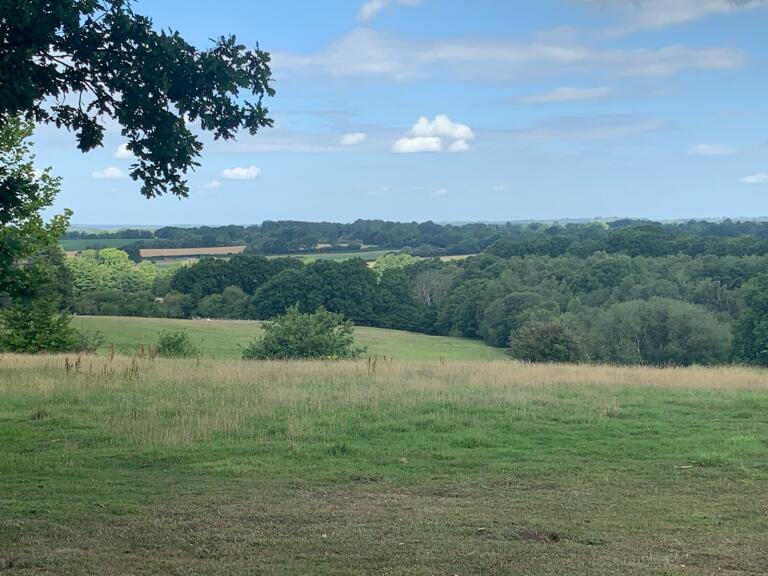 I stopped and sat on the edge of a bridge over a stream and refuelled with a protein bar and some water. I heard the cry of a bird which I was pretty sure was a buzzard. My Chirp app didn’t concur with my deduction but the options it suggested really didn’t match. On checking the call of a buzzard on Google, I’m quite certain that is what I heard. It was such a lovely tranquil spot so I sat for a little while meditating…..going within ……..letting go.
I stopped and sat on the edge of a bridge over a stream and refuelled with a protein bar and some water. I heard the cry of a bird which I was pretty sure was a buzzard. My Chirp app didn’t concur with my deduction but the options it suggested really didn’t match. On checking the call of a buzzard on Google, I’m quite certain that is what I heard. It was such a lovely tranquil spot so I sat for a little while meditating…..going within ……..letting go.
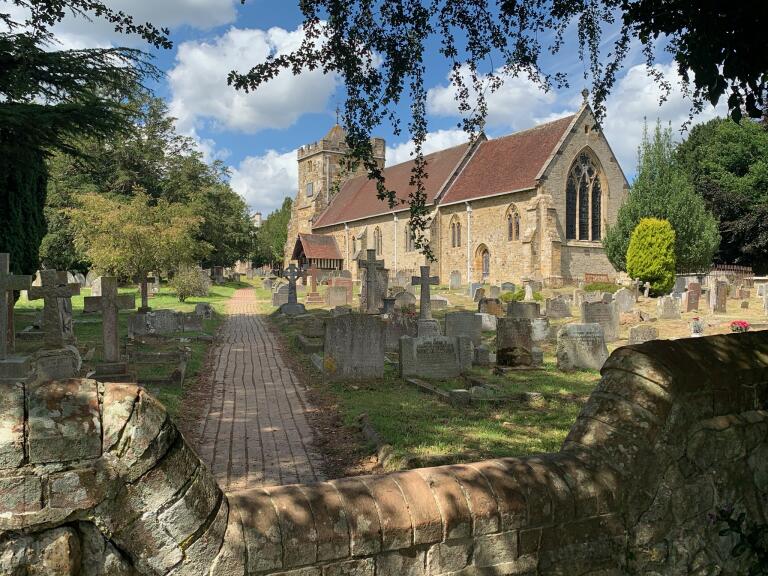 On leaving the bridge I crossed several fields before reaching the beautiful church of St. Mary’s Newick. There were some very well tended, ancient and interesting tombstones surrounding it. I tried to go inside the church but it was closed.
On leaving the bridge I crossed several fields before reaching the beautiful church of St. Mary’s Newick. There were some very well tended, ancient and interesting tombstones surrounding it. I tried to go inside the church but it was closed.
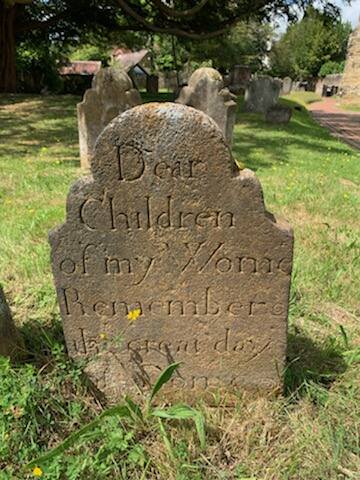 Another of FSH Patrons lives in Newick- Baroness Cumberlege, who has been at the centre of healthcare policy for decades, chairing national Reviews and acting as a Government spokesperson in the House of Lords. Julia has been a great ambassador for FSH and she and she and husband Paddy are very supportive of our events.
Another of FSH Patrons lives in Newick- Baroness Cumberlege, who has been at the centre of healthcare policy for decades, chairing national Reviews and acting as a Government spokesperson in the House of Lords. Julia has been a great ambassador for FSH and she and she and husband Paddy are very supportive of our events.
 I continued through some playing fields across the lane and met up with Daisy, a four month old, blue and tan, German Shepherd and her “pet parent” Sue. I’d not heard that description before and was amused by it. Daisy appeared to be frightened of the skateboarders, who were performing dazzling acrobatics on the purpose built ramps…… Daisy wasn’t impressed.
I continued through some playing fields across the lane and met up with Daisy, a four month old, blue and tan, German Shepherd and her “pet parent” Sue. I’d not heard that description before and was amused by it. Daisy appeared to be frightened of the skateboarders, who were performing dazzling acrobatics on the purpose built ramps…… Daisy wasn’t impressed.
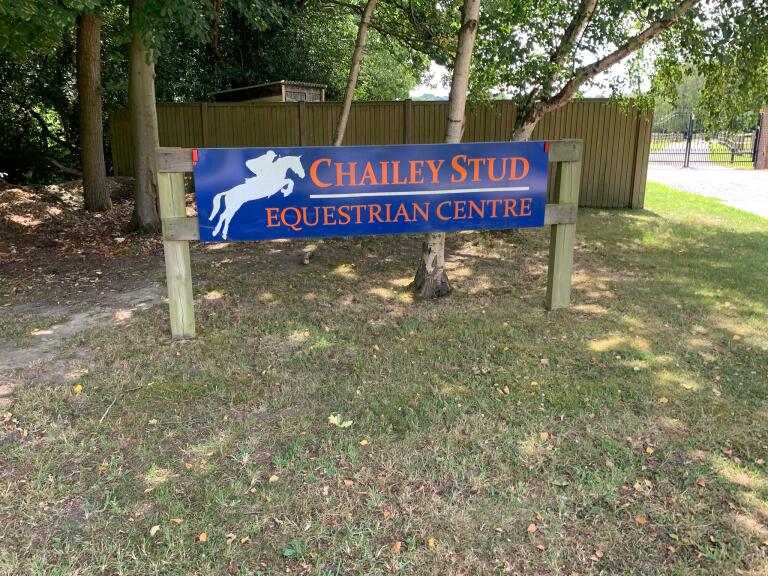 A few more fields led me to the A272 along which I walked for almost a mile, passing the Chailey Stud Equestrian Centre, to the Cafe marking the end of this walk.
A few more fields led me to the A272 along which I walked for almost a mile, passing the Chailey Stud Equestrian Centre, to the Cafe marking the end of this walk.
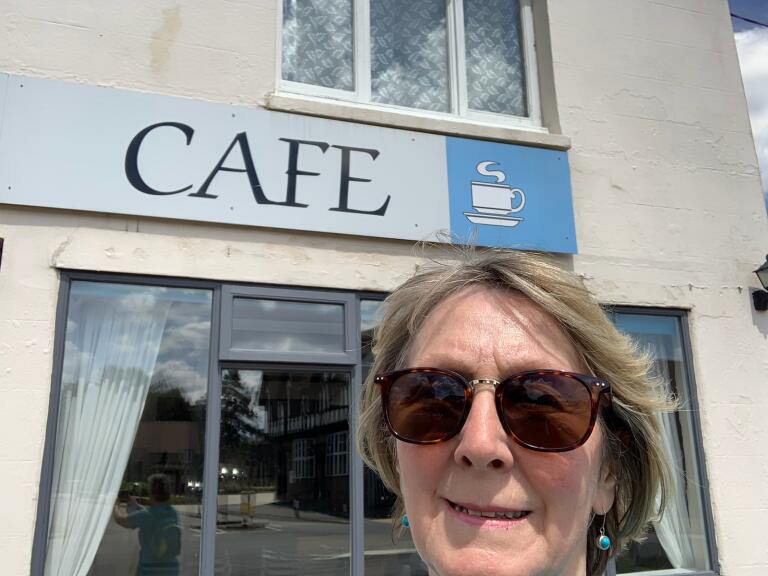 This section of the Trail was generously sponsored and tracked by Hugh Thwaites in appreciation of the excellent work done by St Peter & St James Hospice.
This section of the Trail was generously sponsored and tracked by Hugh Thwaites in appreciation of the excellent work done by St Peter & St James Hospice.